#this is what contemporary artists are missing
Note
Do you have any opinions on modern (post-1970s) movies that you feel capture the essence (in a good way) of Old Movies?
No, unfortunately. That doesn't mean I don't like modern movies or that modern movies aren't good, but modern movies—and here I'm really using modern to mean post-2010, so contemporary movies—have different standards for pacing, characterization, budget, and production that make it harder (or impossible) to capture some of the magic of old movies. Even when modern movies clearly try to emulate that old-movie feeling—I'm thinking of La La Land, The Artist, The Shape of Water, In the Heights—they play the homage too broadly, or they ignore crucial components that make the original films work.
There's kind of too much to go into here without writing a full essay, but essentially, the Old Hollywood system—ugly, failed beast as she was—made some movies simply more accessible to make, due to the ongoing storage of props, sets, master craftsmen, crew, and onscreen talent that could move from one movie to the next without pause. If you needed a dancer, he was already on staff. If you needed a fancy bed, it was already in the warehouse. That kind of longterm storage is invaluable if you want to crank out movies quickly and cheaply because it saves so much time on individual negotiation and sourcing. Modern production companies have to work out individual contracts for every actor on every film; crew members have to negotiate rental contracts and source pieces from scratch; if you need someone with specialist skills, you have to contract them specially at a high rate, which a lot of small companies can't (or won't) budget to do. There's sand in the wheels where there needn't be any. It's wasteful, and costly, but that's the system modern movies are made with.
Which all means that even if the modern movie system wanted to make a classic movie musical just like the old ones, they couldn't, because the talent isn't already there—it hasn't been trained up enough, and there's not that breadth of knowledge you can only get from people who have been allowed to work in the same department in the same place for decades. Movies like La La Land fail, for me, because they present themselves as descendants of Fred Astaire or Busby Berkley movies, while missing the bit where Fred Astaire was a master of his craft. When you watch Fred Astaire dance—or Moira Shearer, or the Nicholas Brothers, or Ann Miller—you are watching a true artist at work, purposely showcased by the studios because they already have them on contract. Modern movies, on the other hand, tend to take people who already have star talent (as actors) and try to convert them into dancers/singers—or they pull dancers/singers off of Broadway, but then they don't have the star power built in. You end up with lackluster musicals where no one truly knows what they're doing, or they do but they're not built up enough by the studios to sell. And that's me discussing just on-screen talent for musicals—there is a huge loss behind the scenes, as well, for all kinds of movies, where roles that would have been filled by union crew who moved continuously from one job to the next have been swapped for freelance labor who live with immense turnover, financial insecurity, and knowledge loss. You could hand me the budget and I could try to make an old movie, but the industry itself has changed so much it's impossible to recapture that charm of steady, niche talent, the amazing possibilities of bonkers set design, and the ability to take a risk on a smaller movie because the other films being produced by the same studio can help balance the budget.
I've talked way, way too much about all of this! Sorry, I just have a lot of thoughts—and the one above is just one of them; the talent loss and storage issues are only facets of a much bigger problem that extends to how we watch movies today, how we market them, what we expect of them, and what's allowed in them. It's a crying shame because the talent is still there, but times change and so does the industry, for better or for worse. (And, just again to clarify, I don't think modern movies are bad—they're just missing a lot of the juice old movies got to play with, even if there's more talent available than ever before.)
257 notes
·
View notes
Text

Fiona Lisa
#got bored#made new and original and special nd art#you could never#this is what contemporary artists are missing#nancy drew games#clue crew#dan#danger by design
201 notes
·
View notes
Text
You Should Get A Radio
I want to convince you to get a radio. It can be a pretty cheap one - you can sometimes thrift them even - just something to listen to the music and shows that are literally streaming completely for free all around you right this very moment.
Libraries get a lot of love - deservedly so. They are such a frugal resource for entertainment and the community at large. I would argue that radio is very similar.
Find New Music
Radio can introduce you to music you never would have run across otherwise. Spotify and the like have a goal of getting you to listen for as long as possible. This incentivizes the alorgithm picking your music recs to stay very safely within your known listening profile. But since a radio station is broadcasting to a large number of people, not you individually, you're more likely to run into music you personally wouldn't have picked but actually enjoy.
Not to mention that if you're in the US at least, you're very likely within range of a public broadcasting station which not only has local and national news, but various music shows as well - World Cafe is a treasure. College radio stations, if you have one nearby by, can be hit or miss, but in general, it is a great way to find local and very niche music you wouldn't hear played anywhere else. If you're in a city, you very likely have a couple of hyperlocal low power FM stations - many who serve communities who don't speak English and who have their own unique music programming. I also enjoy a lot of the adult contemporary and "oldies" stations I can get near me.
The Ads Aren't Targeted
On most stations, you'll hear some ads. Some stations you'll hear more than a few. But none of those ads are based on an ever growing mass of information being collected about you and your listening habits to decide what specific ad you're most likely to actually act on. They're just...an ad. When you turn it off, it can't follow you around until you actually buy it.
Also, if you're listening to local stations, a lot of the ads are for local businesses in your community; places owned by your neighbors and the people you live with. For me, it's been a nice way to be reminded of what places exist in my community since I usually go to my regular haunts and nothing else.
Frugal and Fun
Radios can be pretty cheap. I see them in thrift stores pretty regularly around here and you might be able to try Marketplace for one. Mine was a birthday gift and I paid a little more to upgrade the antena later. Mine uses rechargeable batteries but I think they make ones that are just straight up rechargeable now.
Since I can't control the music, I'm not turning to it to skip through music or pick a different playlist or look up a given artist I want to hear because I just remembered they existed. I'm more present, whether I'm just listening to the show or pairing it with something else (recently it's been knitting or solitaire games).
Similar to the way that libraries can be one way you decrease your reliance on subscription culture, radio is another. Especially for public broadcasting stations, the programming is always changing, there are new shows every week, and there are often ways for you to get involved. It's another form of entertainment that often gets overlooked.
It's Screen Free
Not much to say here. It's just a big plus to me. I'm trying to take more breaks from screens and make the time I do spend on screens less addictive. I like that I can throw on a radio station and listen to a show without ever having to resist the urge to check email or something.
Vital in Emergencies
Have you thought of how you'd get information during an emergency if the internet goes out? Radio is a great option and still regularly saves lives. In the event of emergencies, local radio stations are often some of the very first people to get information on where shelters are being set up, where resoruces are being distributed, and how to stay safe through the course of the event. Depending on the event, emergency managers will actually bring in radio equipment to keep broadcasting going if there's been damage to a tower and even set up temporary/mobile station up to get the word out if there's not a local station they can partner with.
On days when the weather isn't looking so great, I often have the weather band radio turned on so I can get the latest NWS forecasts and hear when a watch is issued - phones usually only get warnings unless you go out of your way to sign up for more. And out where I live, I usually don't even get those since cell signal is spotty.
It's a great investment in your safety that you can also enjoy whenever.
Conclusion
Buy a radio. Especially if you're looking to get away from subscriptions and cut costs. You can own your radio - you can't own Spotify. It's also just something I think everyone should have since it's such a vital resource in emergencies.
ETA: I am a young millinial. I grew up with radio and remember a time before the internet so I'm not saying any of this as if I'm discovering it. It's more I've been not only enjoying it a lot lately but reminded that a lot of people aren't aware of everything it offers so I wanted to share that in case it was news to anyone.
#I don't know what to tag this#radio#frugal#social sobriety#low screen#no screen#it's just a very good idea okay#cord cutting
383 notes
·
View notes
Text
"f1 drivers as happy taylor swift songs"
happy testing week everybody!!

Charles Leclerc
yeah, you know i did one thing right🩷
he watches as you mutter conspiratorially with his mother, whispers in each other's ears and shooting glares to whoever dares eavesdrop. sitting on his childhood sofa, he reflects on the past and his life, pondering in the moment of silence. and there is this voice in his head that talks to him, reminding him of every regret, every single person he's loved and lost. he tries to shut the voice out, knowing full well the negativity never does any good. but as arthur had put it at dinner earlier, it seems as though he's been more relaxed of late. he brushes it off, but as his eyes train on the one he loved getting along swimmingly with the woman who loved him first, he thinks to chalk it up to the tiny nagging voice in his head that had appeared a few days ago out of the blue. the voice was a stark contrast to its predecessor, this one a ball of golden light, saying that maybe he's fucked up a lot, but at least he's got you.
Carlos Sainz
i know heaven's a thing, I go there when you touch me, honey💕
there is this undeniable tingle in his spine when your soft skin presses against his. even in the blistering Spanish heat, he welcomes any skin contact from you. he glances down at where the floppy sunhat blocks most of your face from the sun, and your eyes from his. wondering how much trouble you would give him if he flings the dreadful hat into the ocean, he misses the request you direct up at him. repeating the question, he nods, taking the suncream from your outstretched hands. he takes his time with the lotion, savouring every second his hands are on your back. you thank him with a quick press of your lips to his cheek and he rests a hand on your thigh, bending down to steal another from your lips. his love language was definitely physical touch, especially if it was yours.
Danny Ricciardo
i dared you to kiss me and ran when you tried💚
the sunshine is warm on your skin but the shoulder that brushes against yours is warmer. danny’s contagious laughter is carried by the gentle breeze that passes through the park. at age 9, danny had charmed your mom enough to let him bring her 7-year-old out on an adventure. your peripheral vision shows a teenage couple giggling over clasped hands, and when you’re young, you don’t think of the consequences, so the words slip out. “i bet you won't kiss me right here, right now”. and danny leans in, always ready for any challenge. and just as your lips are about to meet, you burst into laughter, darting away. you can still remember delightfully screaming through the public park as danny gives chase. it’s the same park he proposed in, after all.
George Russell
you wish it was me, don't you?💜
immersed in the classy ambiance of an art exhibition, george navigates the gallery adorned with bright splashes of paint marked contemporary. despite being engaged in interesting chatter, an inexplicable force compels you to lift your gaze, and it locks onto the familiar curls across the room. amid the elegant hum of hushed whispers, the air shifts, his lingering eyes meeting yours, giving rise to a thump in your chest. as his blue orbs drink in your form. once. twice. the rising tension manifests in the prickle of your bare shoulders and the unspoken question echoes amidst the artistic expressions. you yearn to step closer, to be the one on his arm. but long strands of brown silk and emerald green are in your place. and though his eyes long to meet yours again, there is nothing but empty space in your stead.
Lando Norris
so baby, can we dance through an avalanche?🖤
you drop the heavy box on the floor, the fatigue in your bones too wearisome to hold you up any longer. coupled with the emptiness of your apartment and the lack of a certain laughter in the stagnant air, you crumple onto the unmade bed. lying there for what seems like eternity, the thoughts of your future and whatnot plaguing your mind. the weight of unemployment burns heavily, so much so that you miss the sound of the door letting someone through. another body sags beside you, the familiar cologne staining your nostrils. your head turns, finding purchase in the shoulder beside. the stupid orange shirt reminds you of your limited time with him and something clicks. the home system is called upon as a DJ, playing soundtracks of celebration as you pull your boyfriend around the room in a made-up waltz, laughing at his put-out expression and then over the absolute misery that is life. despite the chaos, your heart still finds comfort in its other half’s presence.
Lewis Hamilton
romance is not dead, if you keep it just yours💙
as you clean the apartment you share with lewis, your gaze falls onto the cream card hidden just between your books. Persuasion and Porchia, you note. the seal on it a light purple, the shape of a heart in the hardened wax, and you can picture your boyfriend sliding it onto your bookshelf before he had left for another race this morning, a smirk on his face as he imagines you finding it, and you already know what it is. tracing the edges of the envelope lightly, you break the seal and slide the pages out, unfolding it to reveal the handwriting you had come to reverent. in swooping sloping cursive letters, he proclaims his love again, like he does in every single one of these. and as cheesy as it is, you treasure every single one of them, tucking them away in a little box at the corner of your wardrobe. someday when you have kids, maybe you'll take it out to show them just how deeply their father loves.
Max Verstappen
i don't belong, and my beloved, neither do you🩶
he knew this. he knew full well his career would take him across the world for three quarters out of the year and yet, the one thing he failed to realize was that nothing would feel like home. and then he found you, the absolute enigma that chose to do the same thing he did, realising early on that your home wasn’t in a place. and the streets of Kyoto were just lifeless alleyways till you pointed out the cosy glow of the warm streetlights with your brown streaked hair that shined gold under them and the dark nightscape with the way you shined in his eyes. you did the same for the beaches in Miami and balconies of Spain, easing the loneliness in his memories. slowly but surely, the words you had spoken to him were coming true and his home was taking the shape of you.
#f1 headcanons#f1 imagine#f1 fluff#f1 x reader#formula one fluff#formula one x reader#charles leclerc fluff#charles leclerc x reader#carlos sainz fluff#carlos sainz x reader#daniel ricciardo fluff#daniel ricciardo x reader#george russell fluff#george russell x reader#lando norris fluff#lando norris x reader#lewis hamilton fluff#lewis hamilton x reader#max verstappen fluff#max verstappen x reader#my writing#itsvelyria
194 notes
·
View notes
Text
Big Dumb Hot Cop & Effete Possibly Sociopathic Genius Consultant: A Manifesto
So it has recently come to my attention that this, my archetypal pairing formulation, has broken containment, probably because I've been flinging these terms around like a deranged person wielding a blunt instrument. Therefore it behooves me to explain what the hell I mean by all these adjectives, and who are some classic and contemporary examples of the idiots under discussion—who are by the way extremely in love with one another whether they realize it or not. (Don't you say "bromance." Don't you dare SAY that word to me.) I will use blorbo from my shows to illustrate.
I first realized that I am in fact a Big Dumb Hot Cop whisperer thanks to Chinese police procedural 猎罪图鉴 | Under the Skin (2022). Right away, it's very important to note that Big Dumb Hot Cop is NOT in fact all that dumb. He's only less intelligent IN COMPARISON to his Effete Slightly Sociopathic Genius Consultant, who is, as already stated, a genius. Big Dumb Hot Cop is in fact ruthlessly good at his job. He's driven, he obsesses about cases, he can walk into a crime scene and pick up on the one thing everyone else has missed. There is no suspect he cannot intimidate upon investigation. And he's even better when he's working with (or against, depending on what stage they're at) the genius consultant. They need each other, whether they're fighting or collaborating. They can only clear cases together.
Here are, then, police captain Du Cheng and his genius consultant, sketch artist Shen Yi, eyeing each other significantly as some witness is, I think, lying his face off? Honestly I can't even remember what's happening because the important thing here is their nonverbal communication. This is crucial for this pairing. They can think circles around each other without saying a word. Love that for them.

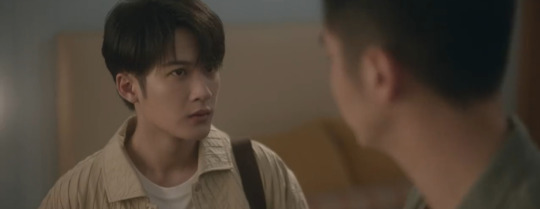
Effete Possibly Sociopathic Genius Consultant has two levels of Possibly Sociopathic. Most maddeningly of all, he has secrets. Sometimes many secrets. So at first, Big Dumb Hot Cop is going to think he's the criminal, or in some way involved in the wrongdoing. The second level is that he'll find Genius Consultant just worryingly, disturbingly good at predicting criminal behavior. And he will continue to be suspicious of him for exactly one or at most two episodes, until he's then swept off his big dumb feet by the rapidity and correctness of Effete Genius's deductions. There's nothing Big Dumb Hot Cop loves more than solving cases. Well, maybe beer. He also loves beer. Once he sees that Effete Consultant is useful, he'll do a 180º and stop complaining to his chief of police, and instead start demanding that Effete Consultant be his forever. He'll start hanging out in his office. He'll literally drag him to crime scenes by the wrist.


(And did I mention Effete Consultant must be very pretty? Did I mention that? He is lovely. Long, thin fingers to steeple while he thinks. Delicate features. Haunted dark eyes. Never sleeps. Shocking self-neglect. You may see where I am going with this.)
Another important attribute of Big Dumb Hot Cop: he's big. Or anyway strong, or a gifted fighter. Let's face it, he has to be, because Genius Consultant is going to be reckless with his own personal safety to the point of stupidity (now who's dumb, huh?). For example, consider another Chinese procedural, S.C.I. 谜案集 | S.C.I. Mystery (2018). Captain Bai Yutong is sort of impossibly physically talented (former fighter pilot! national sandu champion! runs over moving cars and then shoots at them, like some kind of weird urban biathlon!) and, like all good Big Dumb Hot Cops, his entire life is thrown upside down because he now has to drop everything to protect his effete consultant, criminal psychologist Dr. Zhan Yao, who's so careless with himself that in any another drama he would probably be driving Bai Yutong to drink. Thanks to the danmei on which SCI Mystery is based, however, we can safely assume Bai Yutong is taking it out on Zhan Yao in blow jobs.
Note that Bai Yutong is the cook, even though he's the gong, and that he moves in with Zhao Yan to "protect" him from...something, I can't ever remember what, and then just sort of forgets to move out again. For the length of the entire series.


I would argue that 镇魂 | Guardian (2018) is a procedural, even if it also has ghosts, a talking cat, snake lady, eerie dark energy that gets flung around like paintball splatters, and a whole bunch of other supernatural stuff that was not approved of by Big Red (it's based on a danmei of the same title by Priest, a novel which has been pulled from circulation for censorship). Further confusing matters, Zhao Yunlan isn't particularly Big or Dumb, nor is he even really a Cop, technically; but I'm claiming him for this genre not least because of his Effete (drop-dead gorgeous) Possibly Sociopathic (Chief Zhao thinks he's a suspect for a good third of the story) and Definitely Genius, Later Gangpressed into being a Consultant, chock-full of secrets Professor Shen Wei.
Once they finally team up, though, they do this genre/pairing proud. Why, there's nothing they can't solve except how to stay alive. Look at them here enjoying some fine nonverbal communication: "Oh my god, you're just like me—you too will fling yourself directly into bodily harm in order to save a clueless civilian. Okay this could be inconvenient for both of us. Also wow for a genetics professor you're really fucking built, do you lift my bro." (Yes. Yes he does lift.)
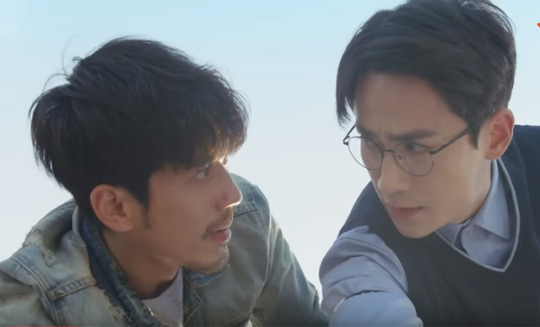
A final example: the cruelly short-lived 光渊 | Justice in the Dark (2023), which like Guardian is based on a danmei by Priest, 默读 | Silent Reading. I got baited into watching the eight (8) existing episodes by seeing a cut of Captain Luo Wenzhou taking on like forty guys with a champagne bottle, a pair of curtains, an axe handle, and a birthday cake, like some kind of cultivator. He's so big and hot, and he's so very dumb. He's also a cop, and ACAB (which is sort of the plot of Silent Reading); and Fei Du is possibly using him for his own nefarious ends (cf. possibly sociopathic and secretive). But underneath all of Fei Du's "I am the abyss, fear me, rawr!" scary posturing, like a puffed-up kitten, he's just a very pretty tender-hearted effete genius, and you can watch Luo Wenzhou melting, and practically pinpoint the exact moment when his whole heart flies out of his eyes and he decides: Yeah, okay, that's it for me. That one. The annoying little traumatized fuerdai with some kind of a death wish that I do not understand. I'll be throwing myself in front of bullets for him and/or cooking him dinner for the foreseeable future, thanks.
Priest is gonna mess with this dynamic of gong/shou caregiving and safeguarding, because that's what she does; but the fundamental beats are still there. Look at these ninnyhammers, just this second figuring out they're actually kind people who belong to each other.

Here they are confronting a suspect together. (You will notice the large butcher knife wavering in the foreground.) Luo Wenzhou, highly trained, nonetheless cannot de-escalate the situation. It takes a pretty playboy in an arm sling to come wandering into the room, and then, using his superb personal knowledge of what it's like to be traumatized to the point of insanity, getting the suspect to disarm. I just love the way they look at each other, incredulous (Luo Wenzhou) and mock-fascinated (Fei Du). If I ever meet the person who directed this scene I'm going to need to kiss them on the mouth.

Once you accept the gospel of Big Dumb Hot Cop and Effete Possibly Sociopathic Genius Consultant into your media-based life, you'll find it has many applications, not all of which have to be procedurals. Consider: characters from the Daomu Biji franchise, possibly (Hei Xiazi is the biggest dumbest hottest not-a-cop I've ever met). Leverage, in a weird OT3 way. Assorted combinations of Avengers. Teen Wolf fic, absolutely. Various Stargate incarnations. Several other Priest danmei, not only procedurals. Definitely Mysterious Lotus Casebook. Et cetera. (You're on your own with MXTX, though.)
This has gotten long and there are still so many nuances and features and wrinkles and problems with the theory that should be ironed out, but it'll have to do for now. I'll simply close by saying: yes, there is also a classic example and you already know exactly who it is.

#big dumb hot cop#effete possibly sociopathic genius consultant#a rubric for blorbo from your shows#you may use it if you like#or disagree with it if you prefer#or just yell at me#i don't mind#either way i'm kind of a dumb cop myself so#i won't take it personally if you hate this#under the skin#justice in the dark#镇魂 guardian#猎罪图鉴#S.C.I. 谜案集#s.c.i. mystery#光渊#mo du#默读#dmbj#盗墓笔记#and yes wait for it:#sherlock and john#watson and holmes#the original archetype of this pairing
159 notes
·
View notes
Text
The Anti-Bojack: Anti-Intellectualism and the Death of Substance
In the blog essay “Staging Philosophy: the relationship between philosophy and drama”, Kristen Gjesdal opines on the home of philosophy. Many today would consider philosophy a relic of a bygone era with names such as Keikegaard, Voltaire, and Neitzsche. Many don’t know, however, of the close relationship philosophy has always held with the arts. Gjesdal mentions Ibsen in the article, discussing how many playwrights of the time were avid students of philosophy and how many philosophers regarded the arts highly. Nietzsche spoke of social leaders, specifically the religious leaders of his day in Beyond Good and Evil when he wrote, “Men, not great enough, nor hard enough, to be entitled as artists to take part in fashioning man.” Frankly denouncing the power and influence held by the religious men which he felt was more appropriately left in the hands of artists. In fact, Nietzche considered art the definition of culture and hence why he says that artists are the ones who should be responsible for shaping society and defining what it means to be “man”. As such, the expressions of art, poetry to cinema, is a definition of man and inherently a philosophy.
Bojack Horseman is an openly philosophical series that plays with existentialist schools of thought. Having liked several tweets endorsing the comparison of her work to that of Raphael Bob-Waksberg, Vivienne Medrano demands her work be valued the same way. From being favorably compared to Bojack Horseman to being praised as the “Anti-Bojack”. Which begs to question, what does that even mean? First let’s discuss the Philosophy behind Bojack Horseman, then compare the tweets Medrano liked and her series to that of Bojack directly, and then study the overlapping themes and why Medrano’s style of writing makes her storytelling a mockery to the art.
Existentialism in particular has been the darling of the theater for about the last 150 years, though generally ridiculed by “proper” society. For a philosopher to be labeled a nihilist or existentialist was often a denouncement of their school of thought, often for their general rejection of fundamental social structures like ethics. In 1942, writer Albert Camus published his essay The Myth of Sisyphus, rebranding traditional existentialist concepts as Absurd philosophy.
Camus begins his work poised with the question of suicide and whether life is worth living at all. He argues that life is inherently meaningless, an idea originating with Kierkegaard, but while the latter sided with finding purpose in constitutions like religion, Camus argues that religion itself is a philosophical suicide. In the Routledge encyclopedia of philosophy by Charles Guignon, he writes of the criticisms levied against existential and absurdist philosophies in a society awash in moralist anti-intellectualism. He opens this section by saying, “Existentialism has been criticized from a number of different angles. One line of criticism holds that the emphasis on individual freedom and the rejection of absolutes in existentialism tends to undermine ethics; by suggesting that everyday life is ‘absurd’ and by denying the existence of fixed, binding principles for evaluating our actions, existentialists promote an ‘anything-goes’ view of freedom that exacerbates the nihilism already present in contemporary life.” Which comes from this negative misreading of nihilism.
In their video Nihilism: Are We Missing the Point, youtuber Michael Burns of Wisecrack tells an anecdote of his time in grad school where he paraphrases his professor as saying, “This idea of the constant misreadings of Nietzsche’s writings on Nihilism leads to, his words, angry seventeen-year-old atheists.” Which tends to be the issue when discussing concepts such as nihilism, existentialism and absurdist philosophy. Nietzsche, the credited father of the school of thought, is often taken out of context or his views distorted by society’s sensibilities. For one, the quote given earlier extends further into a condemnation of religion by saying, “Such men, with their "equality before God," have hitherto swayed the destiny of Europe; until at last a dwarfed, almost ludicrous species has been produced, a gregarious animal, something obliging, sickly, mediocre, the European of the present day.” Which many an angry seventeen-year-old and moralist has seen as an endorsement of the might-is-right philosophy that nihilism is credited with.
To a lesser extent, Camus writes in The Myth, “I must say what counts is not the best living, but the most living”. It feels like it should be rather straightforward then, the concept of the thought. More equals better, and Camus practically says as much when he later writes “Why should it be essential to love rarely in order to love much?” However, if one follows the first quote to its natural conclusion, he continues, “The most living; in the broadest sense, that rule means nothing. It calls for definition.” His wording may come off confusing as the essay is translated and the theories involved are dense, but Camus clarifies that “most” could mean the sheer number of experiences or the depth of the experience. He is not saying one or the other is the correct answer, but that both are equally valid ways to live one’s life. The focus, then, is not on directing anyone how they should live, but in the manner they should do so. He says, “It is not up to me to wonder if this is vulgar or revolting, elegant or deplorable … Suppose that living in this way were not honorable, then true propriety would command me to be dishonorable.”
Camus, and even Nietzsche, argue that truth is the only ultimate value. It throws back the moralist dilemma by arguing that living to a code of ethics or values when one is not truly that sort of person is to live reprehensibly. Better is it to live authentically “without appeal” as Camus says, than it is to live the lie of following the rules.
Thomas Polzler from the University of Graz in Austria wrote a 2014 article titled “Absurdism as Self-Help: Resolving an Essential Inconsistency with Camus’s Early Philosophy”. Personally, I fundamentally and adamantly disagree with his assessment that there is any sort of inconsistency in Camus’s writings. Camus’s books of The Stranger, The Plague, and The Fall are not inherently inconsistent, but depict his philosophy in layers.
Like water painting, Camus starts with a thin veneer of color, a loose and almost detached protagonist in Meursault from The Stranger. He is a man aware of the absurd as an individual, the story maintaining the focus of a man living aware his life means nothing and thus seems to have an almost neurodivergent disinterested in the world beyond himself. What he feels in the moment is all that matters, so when he commits murder out of feeling uncomfortable from the heat of the sun and the painful blinding of the light, he is then juxtaposed with the ethical society he exists simultaneously within and outside of. Meursault is held up as a sociopath for not wishing to see his mother’s body the night before her funeral and smoking by her coffin. Because he does not cry at her passing, he is deemed a danger to society. Because he goes on a date to a comedy picture the day after, he is denounced as a menace. None of which has anything to do with the man he killed. The trial highlights the absurdity of ethical society and how the moralists demand the appearance of values over actually having them.
In fact, the trial of Meursault closely resembles that of Bojack and Sarah Lynn. The end of season 3, Bojack and Sarah Lynn go on a cross-country drug-fuelled bender to apologize to people Bojack has hurt in the past, stopping at the Griffith Observatory where Bojack has a profound revelation. He talks about living in the moment and how neither the past or future really matters at all. What you did and your legacy don’t matter if you cannot exist now. It is this moment that he realizes Sarah Lynn is not responding. It isn't until season 6 that it is shown that Bojack waited before calling the police and thus played a hand in Sarah Lynn's death. He is taken to civil court by Sarah Lynn's mother and step-father and made to pay them a fine for his involvement. However, is it really justice when Sarah Lynn's mother exploited her in the business and never once supported Sarah Lynn for what she wanted and what her dreams were, or even just who she was? Can one argue that it is justice when Sarah Lynn was sexually abused by her step-father throughout her childhood? Yes, Bojack does have responsibility in Sarah Lynn's death, but so do her parents. The absurdity of it all being that in no way could there ever be justice for Sarah Lynn.
Brief mental health sidebar. While I have to expressly disagree with Polzler’s reasoning, I do agree with his conclusion. Philosophy and especially Absurd existentialism are powerful tools in the journey to self improvement. It is both the line from Bojack where Diane says "That's the thing. I don't think I believe in 'deep down'. I kind of think all you are is just the things that you do." And Dr. Wong in Rick and Morty when she says, “You seem to alternate between viewing your own mind as an unstoppable force and as an inescapable curse. And I think it is because the only truly unapproachable concept for you is that it's your mind within your control … You are the master of your universe.”
It may be shocking to know that Medrano was not a fan of Dr. Wong, considering the scene all about telling and not showing Rick’s problems. However, this is after two and a half seasons of witnessing Rick’s shortcomings and Dr. Wong is not telling Rick’s problems, but rather identifying the solution. In both the words of Diane and Dr. Wong, who we are, comes down to the choices we make. There is no moral argument being made with either of these comments. Bojack asked Diane to tell him that he’s actually a good person deep down. That he means to be good, that despite his actions he doesn’t want to hurt anyone and that his bad behavior is the fault of his emotionally unavailable and narcissistic parents. So really, he isn’t a bad person. Whereas Dr. Wong calls out Rick’s behavior as a choice because Rick knows he is making these choices.
The difference between Rick and Bojack is the level of personal awareness and responsibility. Rick knows he has the power to change, but simultaneously so miserable but is so afraid of change that he turns himself into a literal pickle and risks his own death over confronting his own choice to stay the way he is. It is easier for him to justify his lack of trying by simply claiming this is just what it means to be as smart as he is. Whereas Bojack feels helpless. Bojack was not set up for success as a child, his success was never validated by his mother and thus he never valued himself, and every time he tries to change he has no internal fortitude to keep from backsliding at the first sign of defeat. Rick knows everything that is making him miserable is himself. Bojack externalizes his misery and thus also externalizes the solution to his problems, which is why he lets himself return to square one whenever things don’t go his way.
Absurdism is the recognition that life is meaningless and thus we have two choices: Live or die. But these concepts are not so straightforward when discussed. To live, in Camus’s philosophy, is to live authentically to oneself. That may sound like Rick’s situation of accepting things as they are, but that is only true in the case of the individual genuinely wanting to be that way. Authenticity is a dichotomy consisting of both how we behave and how we feel. In the case of Rick he lies, cheats, manipulates, and behaves cruelly towards his family. However, it is implied and later revealed that Rick genuinely cares about his family, but is too afraid of experiencing loss to really let them in. So he’s abusive and insulting, keeping his family at an emotional distance that keeps them around, but never too close, making Rick miserable. He really wants his family, so his feelings are at odds with his behavior. So in reality, him claiming “this is just how things are/who I am” is just as weak an excuse and removes agency over oneself as Bojack saying “It’s because my mother was never there for me.”
The actions both Rick and Bojack partake in are what Camus would call a philosophical suicide. Concisely put, to commit a philosophical suicide is to remove one’s sense of agency in their own life. How can one claim to be living when they have no effect on anything including themselves? You would exist in a void no different than a dreamless sleep. Your actions are meaningless, your thoughts are meaningless, your feelings are meaningless because you are a passenger to the act of living. Everything else has power, everyone else can influence you, so you may as well be nothing. Camus includes religion in this section of his philosophy, as living for something other than yourself is the same as not living at all. And this encompasses Ethics.
There is a massive difference between being kind because you are supposed to, and being kind because you want to. This delves further into living inauthentically and how that mere act alone results in misery. Even if one is to behave in a way deemed “right” without making the choice, they will inevitably become resentful. There is no such thing as faking it until you make it. One has to actively choose and change themselves on a fundamental level to find happiness, and that takes work. Just as Dr. Wong says, “It’s just work. And the bottom line is some people are okay going to work and some people, well some people would rather die.”
Which gets to the main point.
Medrano’s liking of a series of tweets calling Blitzo the Anti-Bojack has both infuriated and confused me. I suppose that I should be embarrassed at the latter since it's obvious both Vivienne and her fans lack basic media literacy. It’s actually rather spectacular just how badly they misrepresent the situation of the characters in the narrative. I can only break this down comment by comment.
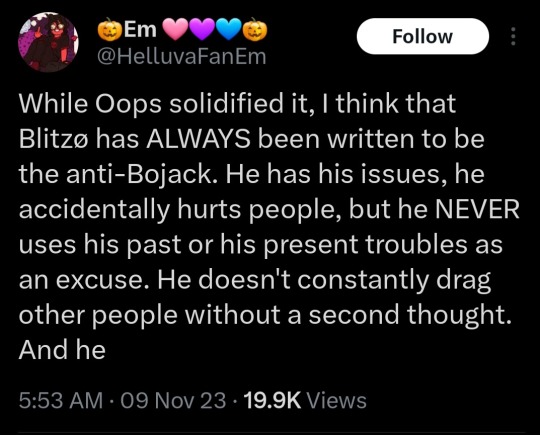
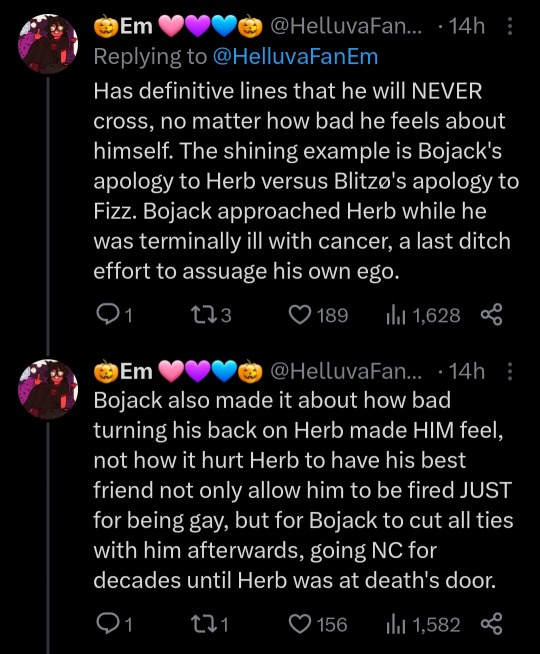
For one, Bojack’s entire character is that he doesn’t intentionally hurt others. He has his reasons that fundamentally comes from a weak sense of self associated with a child who never had the emotional support he needed growing up. Those aren’t excuses, those are the reasons. Bojack has an unhealed inner child who wants to be a good guy, but he is so caught up in his self-loathing and resentment that he doesn’t do anything about that inner child. Instead he indulges these immature emotions through self medicating with drugs and alcohol, lashing out, promiscuity, and careless spending. These are the symptoms of the problem, the problem does lie in past trauma. The issue is Bojack doesn’t see the solution as himself, but someone or something else. In my post comparing Bojack and Todd’s relationship to Blitz and Moxxie, I pointed out how Bojack and Blitz treat their “closest friends” exactly the same by verbally abusing them and tearing down their abilities. While not always consciously intentional for Bojack, it is to keep Todd feeling codependent on Bojack and thus never leaving him which is abusive and manipulative. For Blitz, the narrative says it's because he is aware of his behaviour and is intentionally pushing Moxxie to be better, which is abusive and manipulative.
My point herein being that these are the same people. There is no Anti-Bojack happening here. If anything, Blitz is more malicious in his abuse seeing as he appears actively aware and intentional in how he mistreats Moxxie. Bojack is abusive towards Todd, but in a way that is a reflection of Bojack. And the series acknowledges how Bojack's inability to be alone actively harms his other relationships. Not just Todd.
In one way, however, Blitz absolutely is the Anti-Bojack. Blitz externalizes the source of his behavior to a character failing on Moxxie's part. And the series reaffirms and justifies Blitz's abuse as okay.
The other misconception of this post is thinking that an explanation is an excuse. Creative Screenwriting did an interview in 2019 with Raphael Bob-Waksberg’s process and philosophy of writing Bojack Horseman, quoting him for the title of the article, “Characters should be understandable in their vulnerabilities.” What Medrano’s fans fail to do, fundamentally, is understand. Their opinions and twitter orations are so barren of understanding that one must ask if they simply choose to ignore what does not serve their narrative or if they really are just incapable of comprehension.
They see Blitz’s mother’s death as a reason for his attitude more than his behavior. His behavior then necessitates that it needs to be excusable. As such, Blitz cannot actually make mistakes. Things happen by chance rather than a deliberate choice on any of the characters’ behalf. The fire in Oops wasn’t a mistake made by Blitz, if it is anyone’s mistake, it is the no-named imp who lit the candle before getting to the room. Blitz didn’t intend to bump the other performer, he just happened to turn at that moment. His mistake, then, is one that only makes sense on a metanarrative aspect. His mistake was deciding not to confess his feelings to Fizz. Which… no. As novel as the concept of the butterfly effect was in 2015, the fundamental nature of something inconsequential being attributed to a disaster negates blame. No one is going to blame the butterfly for a hurricane. Similarly, Blitz’s decision to not confess has nothing to do with the fire, in fact the fire itself is not even his accident. His contribution begins and ends with accidentally bumping the other imp; a situation that would have been entirely harmless if not for another character’s unrelated decision made off-screen.
Additionally, Blitz is a heinously insufferable individual who has been nothing but insulting and abusive to his “friend” throughout the series. He sexually abuses Moxxie in Harvest Moon by touching his penis against his will. He threatens to rape Moxxie and Millie in Murder Family. Blitz humiliates Moxxie through emasculation by masculinizing Millie over Moxxie, mocking Moxxie’s anatomy through his weight and genital size, and degrading Moxxie’s hobbies and abilities. Often without any prompting whatsoever and for Blitz’s own personal enjoyment. Blitz simply is a malicious individual, and at one point the series seemed to know that. The issue isn’t that Blitz is an awful person, it’s the lack of acknowledging that fact. The fans and Medrano conveniently ignore who this character is and what he has done to justify him instead of seeking to understand him. This is a running theme throughout the show.
I also briefly compared the scene in Oops to Herb and Bojack in this post, but I didn’t focus so much on the characters and more the metanarrative reason why Bojack worked and Helluva Boss didn’t.
Here, let’s look at why Bojack went to see Herb: Because Herb told him to. Unlike the scenario between Fizz and Blitz where they didn’t see each other for fifteen years and then conveniently run into each other and just so happen to be spotted by Crimson and Striker who, for some reason, know all about Fizz and Ozzie being a thing and they just keep Blitz around because … he’s the main character. Sure, one could argue both Crimson and Striker have a personal thing against Blitz, makes you wonder why they didn’t, you know, do anything to him? No torture or revenge of any kind, he’s just there now. Conveniently tied up and kept with Fizz instead of literally anything else they could have done with him. There is no internal logic to the characters as to why things turn out this way. As seen in the Mammon episode, it's a metanarrative compulsion to make sure Blitz is in every episode regardless of whether it makes sense or goes anywhere, or not.
Another sidebar, but the fact that so much of the series is not able to be explained within the narrative and requires an understanding of how Medrano and her team formulate a script is a huge issue. It removes the ability to properly dissect the characters as individual people and necessitates a reading of them that is how Medrano wants the audience to think about them. When it comes to the character dissections, it is effectively impossible to have a complete or coherent reading in regards to the literary philosophy of the Death of the Author. You have no story or character if you remove Medrano. The world as a whole completely falls apart unless you inject it with her metacommentary and narrative intention like one would preserve a corpse through glycerin. There is absolutely no substance here. And the longer she goes on, trying to compile the whole show into a coherent narrative of its own is like building a skeleton with a human ribcage, an ostrich spine, an elephant skull and the lower half of a barbie doll.
Bojack calls Herb after finding out he is dying from cancer, Herb tells Bojack to come visit him. He refuses to talk to Bojack any other way, and Bojack is compelled to go by his guilt, not ego. Herb calling him to his house obliterates Bojack’s ego, this is Herb’s home and he is the one being summoned. This is where Herb has the most power compared to, say, over the phone. This is not only a move of superiority on Herb’s part, but an act of submission on Bojack’s. Herb forces Bojack to come to him. Once again, this is what power dynamics look like. But, despite the resentment and awkward bitterness, he does want to see Bojack.
I don’t know how many times I can articulate this. Herb is the one in control and he is the one who wants to see Bojack and he is the one calling the shots. Not at all comparable to Fizz being kidnapped, forced to interact with Blitz and then wholly reliant on him due to the narrative in order to facilitate this forced reconciliation. Herb and Bojack are people with complex feelings and agendas. Blitz and Fizz are two dolls being smashed together and held in place by the will of a childish god.
Second, the reason Bojack calls Herb is because he feels guilty, not for abandoning Herb but because he betrayed Herb. He told Herb he would stand with him and walk off the show if they tried to fire his friend, but according to Bojack, he was a coward and didn’t keep his word. He feels guilt for that, he regrets it. But when he apologizes to Herb for it, Herb corrects him. It isn’t because Bojack didn’t keep his word, like the horse man thought, it was because he thought the betrayal was more important than their friendship.
He’s a coward, but not for staying on Horsing Around. He’s a coward because he didn’t believe in their friendship. They were together for years and Herb thought that meant something, but Bojack avoiding Herb and never reaching out to him showed how little their friendship meant to him. And it wasn’t because Bojack didn’t care, Herb knows that. And that fact is necessary to understanding the sequence. Bojack didn’t value the friendship because he thought he was valueless. He avoided Herb because he thought Herb would never forgive him, because that is how little Bojack thinks of himself. Him calling Herb is the active display of him still not forgiving himself, so he needs Herb to do it for him. And Herb knows all of this.
“You know what your problem is? You wanna think of yourself as the good guy. Well, I know you better than anyone else and I can tell you that you're not. In fact, you'd probably sleep a lot better at night if you just admitted to yourself that you're a selfish goddamn coward, who takes whatever he wants, and doesn't give a shit about who he hurts. That's you. That's BoJack Horseman."
Bojack has no value in himself, leaving him extremely fragile. So he took what he wanted, he took their relationship and defined it for both of them. He ran away, protecting himself while determining that this is what Herb would want, and left Herb alone and powerless even in his closest friendship. Which is why Herb demands Bojack come to see him, it’s Herb reclaiming his power in the relationship. And all of this only has any meaning if you clearly define the fact that Bojack apologized for the wrong thing.
There’s an alternate universe where Bojack doesn’t go back and apologize at all, and he and Herb rebuild their friendship anew in Herb’s last days and they simply, quietly agree to start over. Because that’s not off the table. Herb still values the telescope. He still values their friendship. Bojack, once again, takes it away. And Herb, a dying man, fights viciously to keep hold of it. Him not forgiving Bojack is not wanting his friend back, if anything, it’s because he desperately wants Bojack back that he won’t forgive him.
The telescope isn’t just a metaphor when it breaks. It's the symbol of their friendship the entire time, and the physical actions taking place over it are a screenshot of what happened. Bojack took their friendship and left with it. But it meant something to Herb, and you would only know that by how he fights over it now. And when it breaks it shows that, because of Bojack and his cowardly need to run away from his problems, their relationship is now, finally, beyond repair. Not because Herb didn’t forgive him. It wasn’t over when Herb didn’t forgive him. Bojack ended it, not Herb.
But just like Bojack, Medrano and her fans believe that forgiveness is the end all of the story. It’s why so many people were not invested in Fizzarolli and Blitz makeup. Because Fizz just forgiving Blitz makes everything they went through meaningless. It strips the characters and what they went through of depth and nuance in a single moment. It also validates Bojack's general mindset in the belief that one moment can fix a systemic problem. In this case, Medrano isn't the Anti-Bojack, she just is Bojack.
The issue between Herb and Bojack wasn’t the job, or even the time. It was Bojack. And it is the failure of Bojack identifying the part of himself that resulted in this outcome, and not making the choice to do anything different that results in the end of everything. Maybe Herb would never have forgiven the Bojack who left him. But that’s why Bojack needed to be a different Bojack. And he wasn’t.
Wrapping this back around to the start of the essay and how Absurdist philosophy plays into Bojack intrinsically, Herb says exactly that truth to Bojack. That if Bojack was only honest to himself and lived authentically, maybe he would be able to sleep at night. Because being good is less important than being real.
This reminds me of Jean Baptiste Clamence from Camus’s The Fall. A Frenchman in the seedy center of Amsterdam, a city encircled by canals like the rings of hell. He spends his nights in the bar just outside of the red light district, drunk off his ass, it is uncertain if he is actually telling his story to anyone at all. Over the course of four nights, he tells his story of his fall from grace. His self exile to Hell after being unable to cope with his guilt. He tells so many stories of himself, egotistically claiming he has the lost panel of the Ghent Alterpiece in his apartment, the piece titled The Just Judges.
Even his name is a plea for repentance. John. Baptist. Clemency. He claims to sleep with Judges looming over him. Words endlessly flow from him and he confesses his sins.
It’s when he fesses to witnessing the suicide of a young woman in Paris that he explains why he ran away to Netherlands. He says how she called for help after jumping into the water, but he quickly fled the scene, hearing the splashing below become eerily silent. One could argue that he couldn’t do anything. In the Paris winter, the freezing water of the canal could kill them both, let alone the dangers of trying to save someone who is drowning. The main concern being the victim drowning their savior in a frenzied panic of keeping themselves above the water. It could be said that he did the only thing he could. However, he knows she was aware he was there, so she called out to him specifically when she came to her senses. No one witnessed the incident or knew he was there but her, and no one could fault him for doing nothing.
But he feels the guilt in himself, and thus runs away.
Jean-Baptiste, Bojack and even Diane all have the same mentality. They fetishize their misery and trauma, making themselves important through the loops of suffering they inflict on themselves. Thinking that because the events happened to them, it must mean they are somehow special. That their damage meant something out of all the other people on this planet who suffer. That because they felt alone and responsible, they are a mythical chosen one selected from the masses to do something. They find value in the negative self-image they have, their pain being their purpose.
Because if it didn’t matter, why did it happen to them?

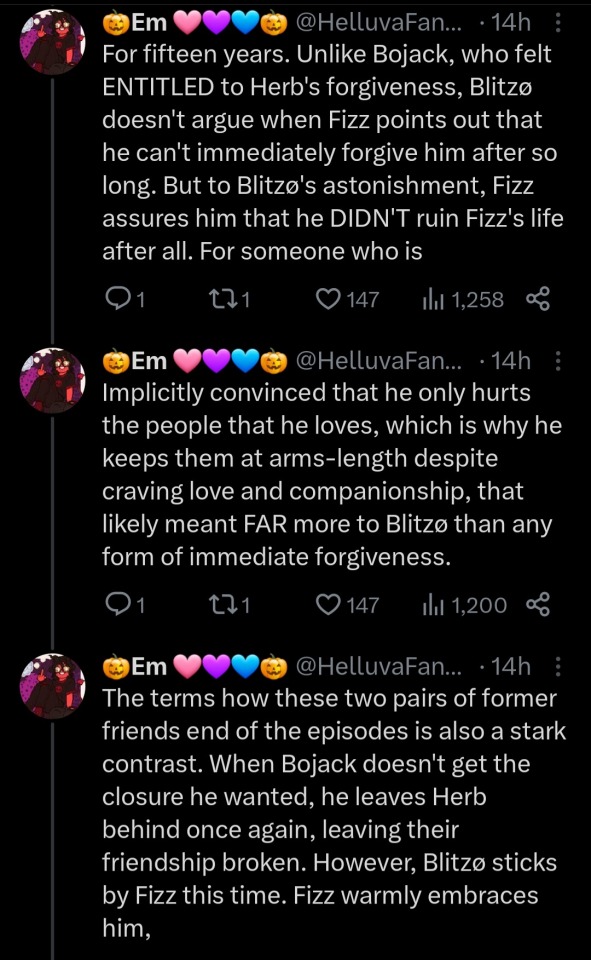
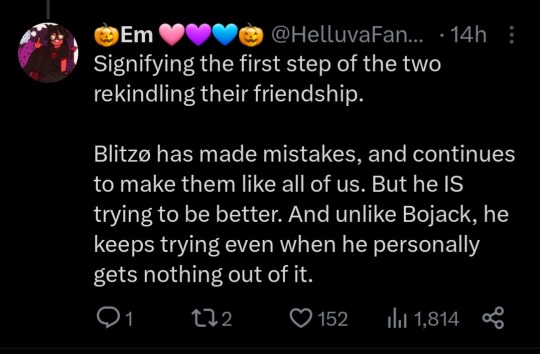
This is where I normally would keep just ripping apart the arguments, but frankly, there isn’t one anymore. For one, the original poster just blatantly lacks any fundamental understanding of Bojack as a series since the entire premise of the show is every season Bojack tries to change.
On a narrative basis, the lack of intentionality on Blitz’s part absolves him from needing forgiveness. Fizzarolli forgiving him holds no weight because Blitz didn’t intentionally set the fire, he didn’t see Fizz in the explosion when he ran away, he didn’t not try to see Fizz in the hospital and then Medrano puts the cherry on top about how Fizz’s life is actually better because of everything that happened. It’s equal parts boring and vile. The conflict is artificial, the resolution is repulsive and contrived. There is no depth to these characters and Medrano actively removes depth, either because she herself lacks the ability to comprehend it or because she knows her fans are incapable of doing so.
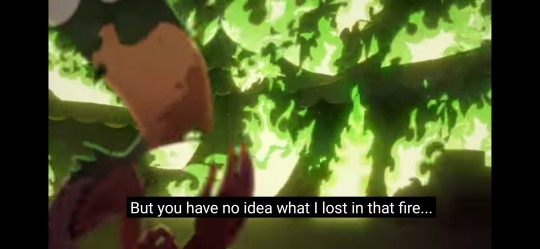
Also, let's just not comment on how this line explicitly overshadows Fizz's trauma. Everyone knows you don't end an apology with "but". That negates the whole apology. This is literally "I'm sorry you got hurt and I can never make that up to you, BUT my mom's dead so you don't even know what it's like being me and feeling responsible for that."
While the writers of Bojack sought to make their characters understandable and thus empathetic, they at no point excused or retconned the behavior. The writers on Bojack didn’t do anything to justify their characters, they were not at all focused on controlling how the audience felt about the characters. They were showing that the characters were well rounded, had reasons, why they had those reasons, what core memories made them who they are today. And the audience had the choice in how they responded to the characters. Medrano needs her audience to feel the same way about her characters as she does in order for the story to work, because she has never put forth the effort of actually telling this story.
One does not need the interviews with Bob-Waksberg to understand his cast and their story. Everything a viewer needs to know can be found in the show proper. There are not huge points of context happening just over there, off screen, between episodes and relegated to background details. Everything relevant to these characters and their stories is in the show. That has not and at this point never will be the case for Helluva Boss. So in many ways, yes. Helluva Boss is the anti-Bojack.
That's not a good thing.
#tw sa mention#philosophy#bojack horseman#bojack horseman spoilers#helluva boss critical#helluva boss critique#helluva boss criticism#vivienne medrano#vivziepop#vivziepop critical#spindlehorse critical#spindlehorse criticism#vivziepop criticism#long post#lots of repetition in places#i get philosophy is dense#its sometimes hard to grasp#especially for this fandom#sources#helluva long post#writing critique#critical thinking#essay writing
187 notes
·
View notes
Note

Oh, doesn't he just look perfect? And funnily enough, I had an idea for a Bucky AU floating around in my head, and this gif gave me the perfect push to write it. So thank you for the gif, love!
An Intriguing Stranger
Plot: Despite how poorly Y/N's night at the Gallery of Contemporary Art is going, it soon starts to look up when she meets a handsome stranger. However, he has a secret of his own.
Pairing: Bucky Barnes x Female!Reader
Warnings: Some swearing and a mention of alcohol. Also Bucky and reader mocking some art. If I miss any triggers, please let me know!
"Care for a drink, ma'am?" A waiter asks, and Y/N grabs a glass off his tray with a smile, following it up with an hors d'oeuvre a moment later. She glances down at the tiny morsel of food in her hand.
"Fucking rich people portions." She hisses. Although, considering where she currently is, the small portions are not too surprising.
Right now, Y/N is standing in the entrance foyer of the Brooklyn Gallery of Contemporary Art. For the longest time, she's wanted to challenge herself, to learn more about the world around her. And what better way to seem cultured than to go to an event hosted at said art gallery?
The only problem is that the second she stepped through the door, Y/N immediately realised that she doesn't like most of the art on display. Unfortunately, though, the ticket cost her a lot of money, and it'll look weird if she leaves so soon after arriving. But mainly, Y/N doesn't want to go because she spent so much time getting ready that she doesn't want her efforts to be wasted. Even if she's not enjoying herself, she'll be damned if she doesn't let everyone see how good she looks.
And besides... not all the art is awful.
Grabbing another filled glass off of the waiter's tray, Y/N stops in front of another painting. The colours are bright, too bright for her liking. She wrinkles her nose disapprovingly.
"Like what you see?" a voice sounds, and Y/N looks up to see a man standing beside her. He runs a hand through his shoulder length brunette hair, smiling at her.
Damn, he's cute. A lot better looking than the art, anyway.
And oh crap, he's staring.
"Well. I don't, really." She admits. The man raises a brow, smirking.
"Oh, really? How so?"
"It's just so bright, and in your face. It looks like the artist just dumped a load of paint on the canvas with no thought of how it would look, or to make something with it. It looks like blobs." A part of her is confused by why she's suddenly unloading her negative opinion on this complete, albeit handsome, stranger, but somehow she already feels comfortable enough around him to do so.
Thankfully, though, the stranger doesn't seem to mind. "I agree. It's chaotic, but I'm not sure if it's in a good way." He nods, tilting his head and nibbling on his finger, as if deep in thought. "It's as if the artist was drunk, and had no care for the complexities of art. He just wanted to make some kind of statement, a 'fuck you', to the expectations of the modern art world."
Damn, this guy really knows his stuff.
Y/N nods, leaning closer to see who the offending artist is. A small plaque reads:
Untitled. James Buchanan Barnes. 2021
"He didn't even title it! Do you think that's part of his 'fuck you' statement?" The man's laughter rings through the air, and soon Y/N's joins it.
"Oh, I know it was." The man clears his throat, grinning once more. "If I may say ma'am, you look wonderful tonight." Heat settles on Y/N's cheeks, and she feels her stomach fluttering. Despite knowing how good she looks tonight, the handsome stranger actually mentioning it is making her go all weak at the knees.
"Thank you." She smiles. But before either of them can say anything else,
"There you are!" another person calls, and Y/N notices an immaculately dressed woman striding over to them. A badge pinned to her chest says 'Gallery Director.' Immediately, fear and guilt fill her veins, and Y/N wonders if she's about to be thrown out of the gallery for her cheek towards the paintings, her chance to seem cultured over before it even began. However, the woman breezes past her, the scent of her undoubtedly expensive perfume intoxicating, and instead, she focuses on the man standing beside her. She takes his hand, shaking it tightly. "My dear friend, it's so wonderful to see you! I'm so glad you could make it."
"It's a pleasure to be here, Natasha." He grins.
"There's a champagne reception for all the guests of honour upstairs. I'd love to see you there." Y/N raises a brow. Her new friend seems to have a lot more influence than she originally thought. Perhaps he's a friend of the gallery? Or a news reporter ready to cover the event?
"I'd like that." As the woman departs, Y/N smirks.
"You didn't tell me you were famous around here." Now, though, it's the man's turn to smirk.
"Allow me to introduce myself." He takes her hand, shaking it. "James Buchanan Barnes. Pleasure to meet you."
James Buchanan Barnes. Huh, that's funny, that's the same name as...
And then, the rudest awakening Y/N's ever experienced hits her, raining down like a tonne of bricks.
Oh shit.
~~~~
Please follow @onceuponastory-library and turn on notifications to be notified when I next post!
#bucky barnes x reader#bucky barnes#bucky barnes x y/n#bucky barnes x you#bucky x y/n#bucky x reader#bucky x you#bucky x female reader#marvel fanfiction#marvel fanfic#marvel cinematic universe#marvel oneshot#bucky barnes fanfiction#bucky barnes fic#bucky barnes oneshot#holacia3
217 notes
·
View notes
Text

saw this post referenced recently and I've been having some thoughts about it
of course I really like the conceit here, and afaict I have one of the most expansive conceptions of "art" in my milieu. so of course I think that painted-over glow-in-the-dark stars in your airbnb can be art, I love this
but op actually doesn't call the thing "art," they call it a "poem," and that's really interesting!
a part of me wants to be critical of this, like, the aspects of poetry that I really like are sonic and verbal and just as much about presentation as they are about content, and I do believe you could take this idea and make a really good poem about it
and this part of me wants to say like, this is emblematic of exactly the things I dislike about much contemporary poetry, where there is I feel very little attention actually given to presentation, to the sound and rhythm and structure of the words themselves, where those things are neglected in favor of directness and cheap emotivity
buuuuut
at the same time I can't deny that there's something really compelling about calling this experience a poem, specifically. it's a metaphor, it draws attention to specific features of the thing that wouldn't be captured by using the more general word "art" and in doing so reveals some things about the way op thinks about poetry. in a word, it's poetic
and I do believe that there are interesting, valuable things about this contemporary idea of poetry, which treats a poem not as an intentional linguistic craft but as something more epigrammatic, juxtapositional
I want to draw a comparison to photography, which I think can be used in a similar way: drawing attention to specific visual features of an object or scene without being distracted by the crafts of expressive or realist painting (both of which can often obscure more than reveal the object being presented)
as op says: the themes are already there. what they want to present is context, is juxtaposition: an airbnb, a ceiling that's been painted over, a missed star. a photograph's lush visual detail would drown out the idea; a ballad's rhythm and imagery would distract from it
you can and I even think should make beautiful things out of ideas like this. but the idea itself is already beautiful, and there's a real artistic craft to noticing that, and presenting it without ornamentation. just, "look at this beautiful thing."
85 notes
·
View notes
Text
Although there have been exceptions, the evolutionary model of man the hunter-warrior has colored most interpretations of Paleolithic art. Only in later twentieth-century excavations in eastern and western Europe and Siberia has the interpretation of both new and old finds gradually begun to change. Some of the new researchers were women, who noted the female genital imagery and also leaned toward more complex religious rather than the "hunting magic" explanations of Paleolithic art. And as more scholars were secular scientists rather than monks like Abbé Breuil (whose "moral" interpretations of religious practices colored so much of the nineteenth- and early twentieth-century Paleolithic research), some of the men who reexamined the cave paintings, figurines, and other Paleolithic finds now also began to question tenets once accepted by the scholarly establishment.
An interesting example of this questioning relates to the stick and line forms painted on the walls of Paleolithic caves and engraved in bone or stone objects. To many scholars, it seemed obvious that they depict weapons: arrows, barbs, spears, harpoons. But as Alexander Marshack writes in The Roots of Civilization, one of the first works to frontally challenge this standard interpretation, these line paintings and engravings could just as easily be plants, trees, branches, reeds, and leaves. Moreover, this new interpretation would account for what would otherwise be a remarkable absence of pictures of such vegetation among a people who, like contemporary gatherer-hunter peoples, must have relied heavily on vegetation for food.
In Paleolithic Cave Art, Peter Ucko and Andrée Rosenfeld had also wondered about the peculiar absence of vegetation in Paleolithic art. They further noted another curious incongruity. All other evidence showed that a particular kind of harpoon called biserial didnt appear until the late Paleolithic or Magdalenian age—even though scholars kept "finding" them in "sticks" thousands of years earlier in the wall paintings of prehistoric caves. Moreover, why would Paleolithic artists want to depict so many hunting failures? For if the sticks and lines were in fact weapons, the pictures had them chronically missing their targets.
To probe such mysteries, Marshack, who was not an archaeologist, hence not bound by earlier archeological conventions, thoroughly examined the engravings on a bone object that had been described as pictures of harpoons. Under a microscope he discovered that not only were the barbs of this supposed harpoon turned the wrong way but the points of the long shaft were also at the wrong end. But what did these engravings represent if they were not "wrong way" weapons?
As it turned out, the lines easily conformed to the proper angle of branches growing at the top of a long stem. In other words, these and other engravings conventionally described as "barbed signs" or "masculine objects" were probably nothing more than stylized representations of trees, branches, and plants.
-Riane Eisler, The Chalice and the Blade: Our History, Our Future
151 notes
·
View notes
Text
How’d They Do That?
Special Effects & Stunts of Silent Cinema - Part 1
This is the first installment of an open-ended series where I try to highlight and illustrate the work of special effects and stunt artists of silent filmdom. Using articles from contemporary fan and trade magazines, I’ll make gifs or dig up images and/or video clips to accompany the descriptions of how the sequences were executed.
My notations will be bracketed and highlighted in a different color. Hope you all enjoy! Fair warning: this is a long read.
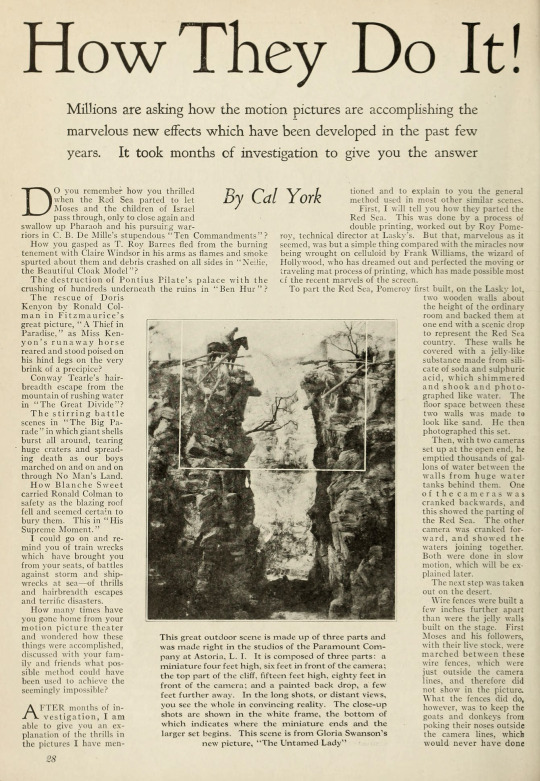
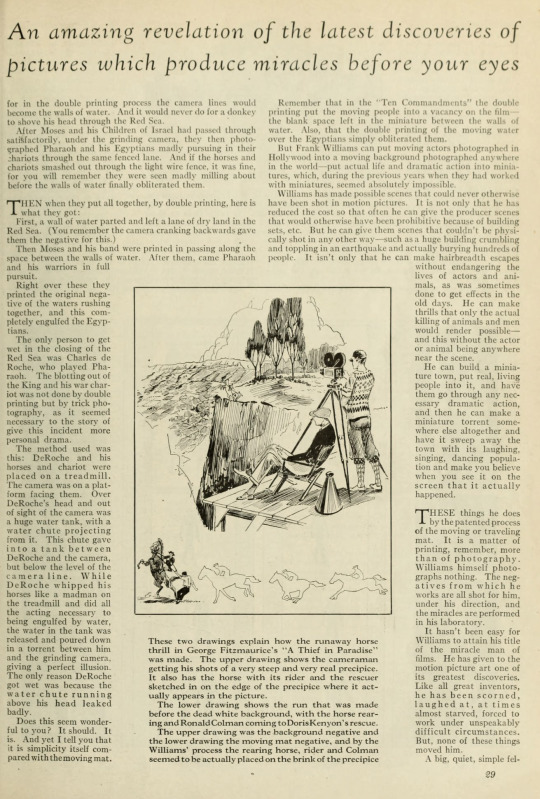
How They Do It!
[from Photoplay, April 1926]
by Cal York
Millions are asking how the motion pictures are accomplishing the marvelous new effects which have been developed in the past few years. It took months of investigation to give you the answer
DO you remember how you thrilled when the Red Sea parted to let Moses and the children of Israel pass through, only to close again and swallow up Pharaoh and his pursuing warriors in C.B. De Mille's stupendous "Ten Commandments" ?
How you gasped as T. Roy Barnes fled from the burning tenement with Claire Windsor in his arms as flames and smoke spurted about them and debris crashed on all sides in "Nellie, the Beautiful Cloak Model"?
The destruction of Pontius Pilate's palace with the crushing of hundreds underneath the ruins in "Ben Hur"?
The rescue of Doris Kenyon by Ronald Colman in Fitzmaurice's great picture, "A Thief in Paradise," as Miss Kenyon's runaway horse reared and stood poised on his hind legs on the very brink of a precipice?
Conway Tearle's hair-breadth escape from the mountain of rushing water in "The Great Divide"?
The stirring battle scenes in "The Big Parade" in which giant shells burst all around, tearing huge craters and spreading death as our boys marched on and on and on through No Man's Land.
How Blanche Sweet carried Ronald Colman to safety as the blazing roof fell and seemed certain to bury them. This in "His Supreme Moment."
I could go on and remind you of train wrecks which have brought you from your seats, of battles against storm and shipwrecks at sea—of thrills and hairbreadth escapes and terrific disasters.
How many times have you gone home from your motion picture theater and wondered how these things were accomplished, discussed with your family and friends what possible method could have been used to achieve the seemingly impossible?
AFTER months of investigation, I am able to give you an explanation of the thrills in the pictures I have mentioned and to explain to you the general method used in most other similar scenes.
First, I will tell you how they parted the Red Sea. This was done by a process of double printing, worked out by Roy Pomeroy, technical director at Lasky's. But that, marvelous as it seemed, was but a simple thing compared with the miracles now being wrought on celluloid by Frank Williams, the wizard of Hollywood, who has dreamed out and perfected the moving or traveling mat process of printing, which has made possible most of the recent marvels of the screen.
[Roy Pomeroy was head technical wizard for Famous Players-Lasky/Paramount (that is to say, he was their head special-effects engineer). We only know for certain about a handful of films that Pomeroy made specific contributions to, like The Ten Commandments (1923) and Wings (1927). As with many journeymen of the silent/studio era of Hollywood, the amount of films Pomeroy worked on was likely substantial, but many technical roles went uncredited at the time.]
To part the Red Sea, Pomeroy first built, on the Lasky lot, two wooden walls about the height of the ordinary room and backed them at one end with a scenic drop to represent the Red Sea country. These walls he covered with a jelly-like substance made from silicate of soda and sulphuric acid, which shimmered and shook and photographed like water. The floor space between these two walls was made to look like sand. He then photographed this set.

Then, with two cameras set up at the open end, he emptied thousands of gallons of water between the walls from huge water tanks behind them. One of the cameras was cranked backwards, and this showed the parting of the Red Sea. The other camera was cranked forward, and showed the waters joining together. Both were done in slow motion, which will be explained later.

The next step was taken out on the desert.
Wire fences were built a few inches further apart than were the jelly walls built on the stage. First Moses and his followers, with their live stock, were marched between these wire fences, which were just outside the camera lines, and therefore did not show in the picture. What the fences did do, however, was to keep the goats and donkeys from poking their noses outside the camera lines, which would never have done for in the double printing process the camera lines would become the walls of water. And it would never do for a donkey to shove his head through the Red Sea.
After Moses and his Children of Israel had passed through satisfactorily, under the grinding camera, they then photographed Pharaoh and his Egyptians madly pursuing in their chariots through the same fenced lane. And if the horses and chariots smashed out through the light wire fence, it was fine. for you will remember they were seen madly milling about before the walls of water finally obliterated them.
THEN when they put all together, by double printing, here is what they got:
First, a wall of water parted and left a lane of dry land in the Red Sea. (You remember the camera cranking backwards gave them the negative for this.)
Then Moses and his band were printed in passing along the space between the walls of water. After them, came Pharaoh and his warriors in full pursuit.
Right over these they printed the original negative of the waters rushing together, and this completely engulfed The Egyptians.

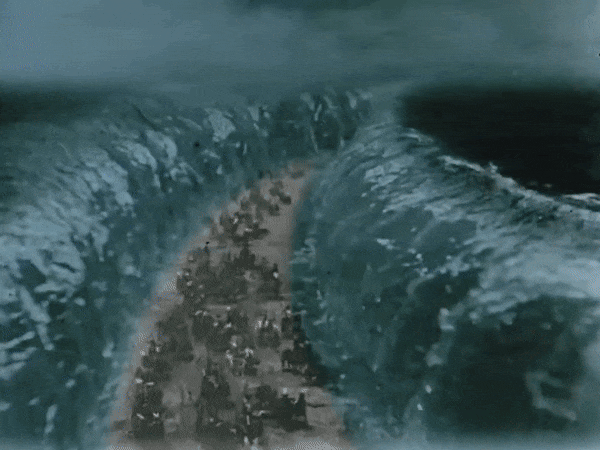
The only person to get wet in the closing of the Red Sea was Charles de Roche, who played Pharaoh. The blotting out of the King and his war chariot was not done by double printing but by trick photography, as it seemed necessary to the story of give this incident more personal drama.

The method used was this: DeRoche and his horses and chariot were placed on a treadmill. The camera was on a platform facing them. Over DeRoche's head and out of sight of the camera was a huge water tank, with a water chute projecting from it. This chute gave into a tank between DeRoche and the camera, but below the level of the camera line. While DeRoche whipped his horses like a madman on the treadmill and did all the acting necessary to being engulfed by water, the water in the tank was released and poured down in a torrent between him and the grinding camera, giving a perfect illusion. The only reason DeRoche got wet was because the water chute running above his head leaked badly.
Does this seem wonderful to you? It should. It is. And yet I tell you that it is simplicity itself compared with the moving mat.
Remember that in the "Ten Commandments" the double printing put the moving people into a vacancy on the film—the blank space left in the miniature between the walls of water. Also, that the double printing of the moving water over the Egyptians simply obliterated them.
READ ON BELOW the JUMP!
---
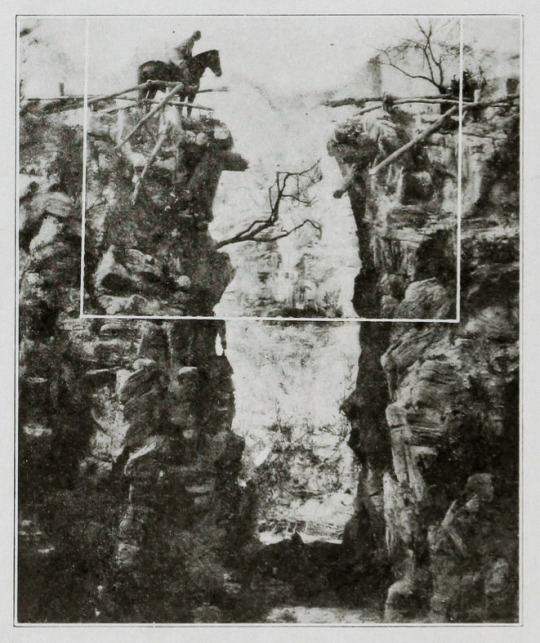
Photo caption: This great outdoor scene is made up of three parts and was made right in the studios of the Paramount Company at Astoria, L.I. It is composed of three parts: a miniature four feet high, six feet in front of the camera; the top part of the cliff, fifteen feet high, eighty feet in front of the camera; and a painted back drop, a few feet further away. In the long shots, or distant views, you see the whole in convincing reality. The close-up shots are shown in the white frame, the bottom of which indicates where the miniature ends and the larger set begins. This scene is from Gloria Swanson's new picture, "The Untamed Lady"
[The Untamed Lady (1926) is presumed lost, but luckily, a few images of this cliff-top sequence have survived.
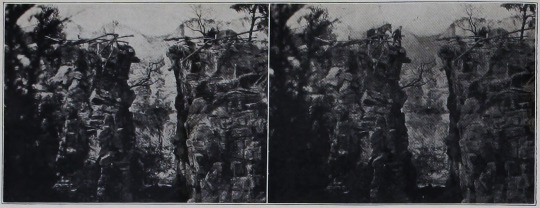

from Exhibitors Herald, 20 March 1926]
An amazing revelation of the latest discoveries of pictures which produce miracles before your eyes
---
But Frank Williams can put moving actors photographed in Hollywood into a moving background photographed anywhere in the world—put actual life and dramatic action into miniatures, which, during the previous years when they had worked with miniatures, seemed absolutely impossible.
[As you can gather from this article Frank Williams was a pioneer cinematographer and special effects artist. Williams was able to patent his moving matte process (and named it the Williams process) and it was an important effects technique used in film as as varied as Ben-Hur (1925), Sunrise: A Song of Two Humans (1926), The Lost World (1925), and The Invisible Man (1933). All of which are extant and easily accessible!
While it wasn’t in regular use for very long, the process was the basis for significant later developments in special effects photography, like green screening!]
Williams has made possible scenes that could never otherwise have been shot in motion pictures. It is not only that he has reduced the cost so that often he can give the producer scenes that would otherwise have been prohibitive because of building sets, etc. But he can give them scenes that couldn't be physically shot in any other way—such as a huge building crumbling and toppling in an earthquake and actually burying hundreds of people. It isn't only that he can make hairbreadth escapes without endangering the lives of actors and animals, as was sometimes done to get effects in the old days. He can make thrills that only the actual killing of animals and men would render possible—and this without the actor or animal being anywhere near the scene.
He can build a miniature town, put real, living people into it, and have them go through any necessary dramatic action, and then he can make a miniature torrent somewhere else altogether and have it sweep away the town with its laughing, singing, dancing population and make you believe when you see it on the screen that it actually happened.
THESE things he does by the patented process of the moving or traveling mat. It is a matter of printing, remember, more than of photography. Williams himself photographs nothing. The negatives from which he works are all shot for him, under his direction, and the miracles are performed in his laboratory.
It hasn't been easy for Williams to attain his title of the miracle man of films. He has given to the motion picture art one of its greatest discoveries. Like all great inventors, he has been scorned, laughed at, at times almost starved, forced to work under unspeakably difficult circumstances. But, none of these things moved him.
A big, quiet, simple fellow, only thirty-two years old. Shy, rather diffident of speech, he makes everything he does look easy. When he comes on a set, his quiet presence is scarcely noticed, and cameramen and technical experts go on spluttering and arguing, and when he is finally appealed to, he settles the problem so simply that everyone wonders why he didn't think of it himself.
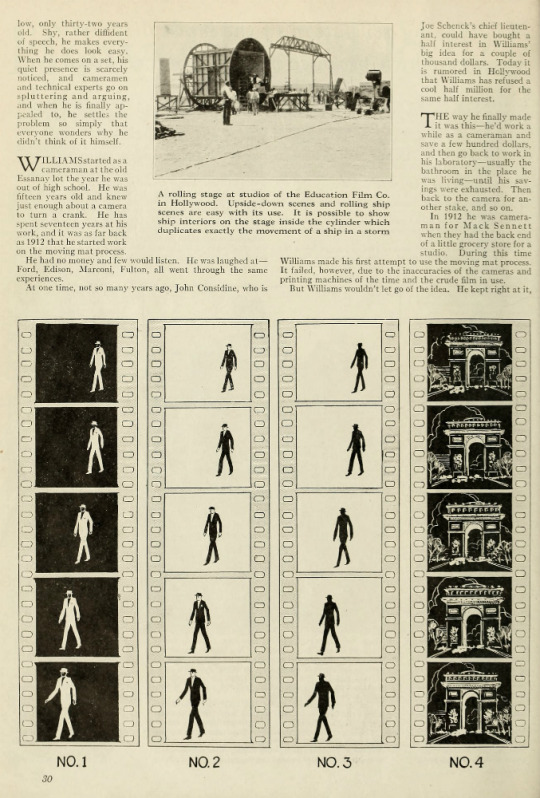
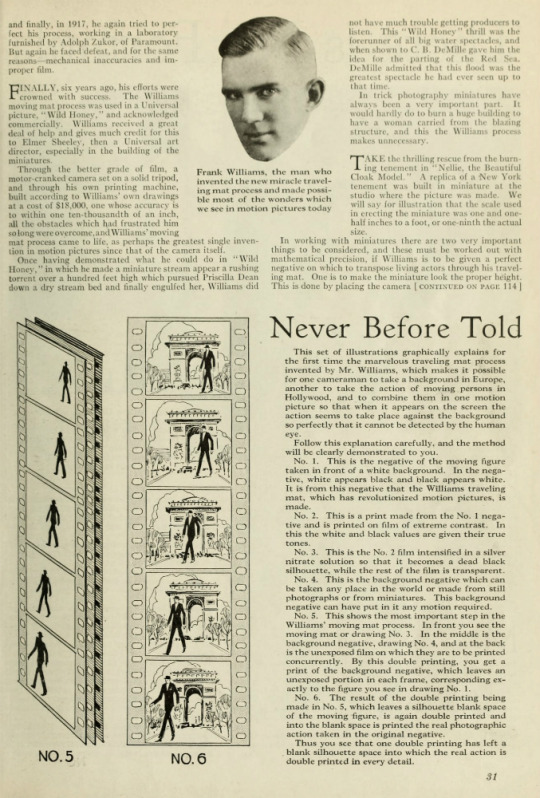
WILLIAMS started as a cameraman at the old Essanay lot the year he was out of high school. He was fifteen years old and knew just enough about a camera to turn a crank. He has spent seventeen years at his work, and it was as far back as 1912 that he started work on the moving mat process.
He had no money and few would listen. He was laughed at—Ford, Edison, Marconi, Fulton, all went through the same experiences.
At one time, not so many years ago, John Considine, who is Joe Schenck's chief lieutenant, could have bought a half interest in Williams' big idea for a couple of thousand dollars. Today it is rumored in Hollywood that Williams has refused a cool half million for the same half interest.
THE way he finally made it was this—he'd work a while as a cameraman and save a few hundred dollars, and then go back to work in his laboratory—usually the bathroom in the place he was living—until his savings were exhausted. Then back to the camera for another stake, and so on.
In 1912 he was cameraman for Mack Sennett when they had the back end of a little grocery store for a studio. During this time Williams made his first attempt to use the moving mat process. It failed, however, due to the inaccuracies of the cameras and printing machines of the time and the crude film in use.
But Williams wouldn’t let go of the idea. He kept right at it, and finally, in 1917, he again tried to perfect his process. working in a laboratory furnished by Adolph Zukor, of Paramount. But again he faced defeat, and for the same reasons—mechanical inaccuracies and improper film.
---
Photo caption: A rolling stage at studios of the Education Film Co. in Hollywood. Upside-down scenes and rolling ship scenes are easy with its use. It is possible to show ship interiors on the stage inside the cylinder which duplicates exactly the movement of a ship in a storm
[The rolling stage was used for lots of imaginative and comedic sequences in shorts and features. In the Lupino Lane short Movieland (1926), there’s a bit that shows the stage in action. Here’s a link to that specific scene, but the whole short is a lot of wacky fun and I recommend watching the full film!
Another illustration of how the rolling stage can be put to use is in When the Clouds Roll By (1919):
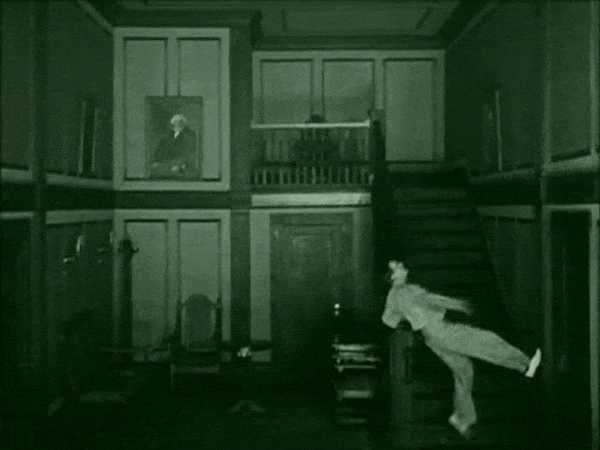

---
FINALLY, six years ago, his efforts were crowned with success. The Williams moving mat process was used in a Universal picture, "Wild Honey," and acknowledged commercially. Williams received a great deal of help and gives much credit for this to Elmer Sheeley, then a Universal art director, especially in the building of the miniatures.
Through the better grade of film, a motor-cranked camera set on a solid tripod, and through his own printing machine, built according to Williams' own drawings at a cost of $18,000, one whose accuracy is to within one ten-thousandth of an inch, all the obstacles which had frustrated him so long were overcome and Williams' moving mat process came to life, as perhaps the greatest single invention in motion pictures since that of the camera itself.
Once having demonstrated what he could do in "Wild Honey," in which he made a miniature stream appear a rushing torrent over a hundred feet high which pursued Priscilla Dean down a dry stream bed and finally engulfed her, Williams did not have much trouble getting producers to listen. This "Wild Honey" thrill was the forerunner of all big water spectacles, and when shown to C.B. DeMille gave him the idea for the parting of the Red Sea. DeMille admitted that this flood was the greatest spectacle he had ever seen up to that time.
[Unfortunately, Wild Honey (1922) is currently presumed lost and I was unable to find any depiction of Priscilla Dean fleeing from a torrent of water. As noted above however, there are quite a few extant films that also used Williams’ moving matte process.
In case you were wondering, I put $18,000 through an inflation calculator and it is equivalent to more than $315,000 in 2023 money!]
In trick photography miniatures have always been a very important part. It would hardly do to burn a huge building to have a woman carried from the blazing structure, and this the Williams process makes unnecessary.
TAKE the thrilling rescue front the burning tenement in "Nellie, the Beautiful Cloak Model." A replica of a New York tenement was built in miniature at the studio where the picture was made. We will say for illustration that the scale used in erecting the miniature was one and one-half inches to a foot, or one-ninth the actual size.
In working with miniatures there are two very important things to be considered, and these must be worked out with mathematical precision, if Williams is to be given a perfect negative on which to transpose living actors through his traveling mat. One is to make the miniature look the proper height. This is done by placing the camera the proper distance from the miniature (of course much closer than if it were a real building), and shooting from a lower level. The other is called timing. For example, if a miniature tree is to fall and the camera set-up is close enough and low enough to give the miniature the proper height when it is seen on the screen, then you must be careful of the speed with which it falls.
A little tree falls rapidly—a big tree slowly. And here is where the timing enters. Ultra speed cameras are used. The faster you crank the more pictures you get per second, and the slower the thing seems to move when you see it on the screen. You have all seen slow-motion pictures. These were made with slow-motion cameras, or what are more commonly termed ultra-speed cameras. And it is through this slow motion photography that the little tree is made to fall at the proper speed to be the big tree it represents, or the miniature stream is made to run at the proper speed for a giant river.
And so to get back to the fire which is still threatening "Our Nell." A torch is applied to the miniature tenement. At the proper count little invisible wires tied to window sashes are pulled and burning brands crash to the street below. And all the time the cameras, driven by motors at the proper speed, placed at the right distance from the conflagration and almost flat on the floor, are grinding away and recording this great fire.
[Nellie, the Beautiful Cloak Model (1924) is extant, with a print located at Gosfilmofond, but the film is not readily accessible. However, a depiction of the burning building sequence appears on an advertisement for the film:

from Film Daily, 28 February 1924]
OVER on some other part of the lot, and at any time which suits the director's convenience, T. Roy Barnes, with Miss Windsor in his arms, dashes through a black velvet door and down a street backed with more black velvet.
Two things must be remembered, however. The actors must come out of the velvet door at the right spot and at the right time or "count." This is necessary so that Williams can match up the fire negative, which is the background with action in it, with the negative of Miss Windsor and Barnes, which becomes the moving mat.
The remainder is simple, and is done by Williams and his printing process over at his laboratory.
On the screen you see Barnes dashing from a burning tenement with Miss Windsor in his arms while, in reality, neither of the actors has been close enough to a fire to singe a single eyelash.
Blanche Sweet's rescue of Colman in "The Supreme Moment" was worked out in the same manner as this, as have been most other burning building thrills in pictures made in the last few years.
[His Supreme Moment (1925) is presumed lost and unfortunately I was unable to locate a depiction of the burning building rescue mentioned here.]
Now for the destruction of Pontius Pilate's palace with the struggling mass crushed beneath, in "Ben Hur." Of course the palace was done in miniature, while the people did their acting out on the lot, where the street was built with a dead white backing. Again the timing had to correspond with that in the falling of the palace.
The throng of people was lined up and rehearsed. Two lines were drawn in the street a fixed distance apart—which represented the space where the ruins of the palace would fall, and the throng was sent dashing wildly down the street. At a fixed signal, all caught between the two marks fell flat on the ground. Those who had not reached the first line halted and registered terror. Those who had passed the second mark fled on, looking back and also registering terror. You see, those caught between the two marks were the people buried under the debris of Pilate's palace—those on either side had escaped.

Then came the trick printing with the two negatives, with considerable painting out of those who had fallen flat between the two lines, and you have the palace falling on the panic-stricken throng in the street. The accompanying drawings will help you to visualize this.
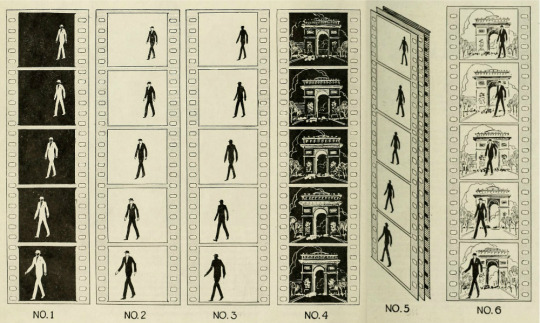
Never Before Told
This set of illustrations graphically explains for the first time the marvelous traveling mat process invented by Mr. Williams, which makes it possible for one cameraman to take a background in Europe, another to take the action of moving persons in Hollywood, and to combine them in one motion picture so that when it appears on the screen the action seems to take place against the background so perfectly that it cannot be detected by the human eye.
Follow this explanation carefully, and the method will be clearly demonstrated to you.
No. 1. This is the negative of the moving figure taken in front of a white background. In the negative, white appears black and black appears white. It is from this negative that the Williams traveling mat, which has revolutionized motion pictures, is made.
No. 2. This is a print made from the No. 1 negative and is printed on film of extreme contrast. In this the white and black values are given their true tones.
No. 3. This is the No. 2 film intensified in a silver nitrate solution so that it becomes a dead black silhouette, while the rest of the film is transparent.
No. 4. This is the background negative which can be taken any place in the world or made from still photographs or from miniatures. This background negative can have put in it any motion required.
No. 5. This shows the most important step in the Williams' moving mat process. In front you see the moving mat or drawing No. 3. In the middle is the background negative, drawing No. 4, and at the back is the unexposed film on which they are to be printed concurrently. By this double printing, you get a print of the background negative, which leaves an unexposed portion in each frame, corresponding exactly to the figure you see in drawing No. 1.
No. 6. The result of the double printing being made in No. 5, which leaves a silhouette blank space of the moving figure, is again double printed and into the blank space is printed the real photographic action taken in the original negative.
Thus you see that one double printing has left a blank silhouette space into which the real action is double printed in every detail.
---
The rescue of Doris Kenyon, which is also illustrated by the artist, was accomplished in this manner. One negative was shot of a very real and very steep precipice, the cameramen suspended on a platform far out over the edge to get the proper angle. Another negative was shot of Miss Kenyon's horse racing madly along what looked like a fence—but what was the inevitable white drop. Doris and the horse had to reach a certain mark at a certain count—for over at the precipice there had been rocks and dirt released at a certain count—the horse bad to rear, and Colman had to reach the frenzied beast, starting from outside the camera line, and he, too, must arrive on the right count. There could be no waiting for man or horse. They took it perhaps forty times before everything was exactly right, and then the two negatives (the precipice background and the moving mat) were ready for the printing wizard, and audiences got a great thrill.
[A Thief in Paradise (1925) is almost entirely lost. I profiled the film in my series Lost, but Not Forgotten in 2023.]
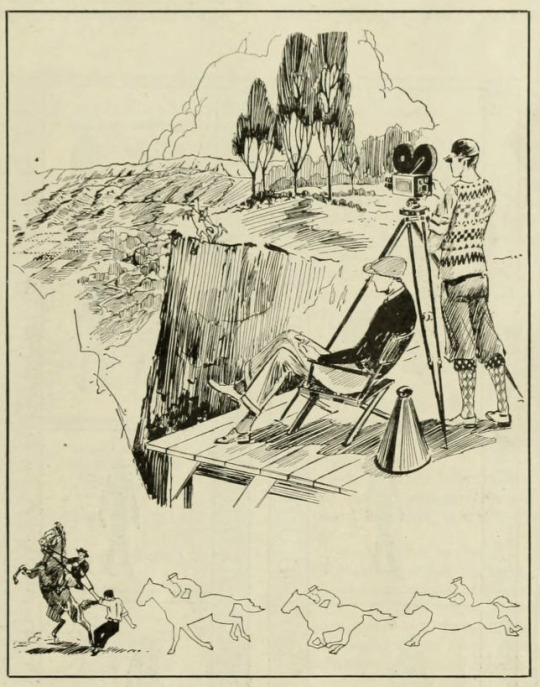
Photo caption: These two drawings explain how the runaway horse thrill in George Fitzmaurice's "A Thief in Paradise" was made. The upper drawing shows the cameraman getting his shots of a very steep and very real precipice. It also has the horse with its rider and the rescuer sketched in on the edge of the precipice where it actually appears in the picture.
The lower drawing shows the run that was made before the dead white background, with the horse rearing and Ronald Colman coming to Doris Kenyon's rescue.
The upper drawing was the background negative and the lower drawing the moving mat negative, and by the Williams' process the rearing horse, rider and Colman seemed to be actually placed on the brink of the precipice
---
You remember the mountain of water pursuing Conway Tearle in "The Great Divide." Of course they shot the torrent in miniature. Conway and his horse made their hairbreadth dash on a dark night and in an artificial rainstorm with nothing but a director threatening —then, although they did have quite a time making the steed climb a slippery and sloping wooden bridge, which was out on the back lot. Then up in Mr. Williams' laboratory, they finished one of the greatest thrills ever witnessed.
[While The Great Divide (1925) is thankfully extant at Cinemateket-Svenska Filminstitutet, it’s not easily accessible and I was unable to find a depiction of the effect.]
And the marvelous battle scenes in "The Big Parade." There were the big guns tearing huge craters in No Man's Land made on one negative, and the boys marched on and on and on in the other negative, and Mr. Williams brought them together in his printing laboratory. However, it was by no means as easy as it sounds, for this was one of the hardest pieces of moving mat printing ever accomplished.

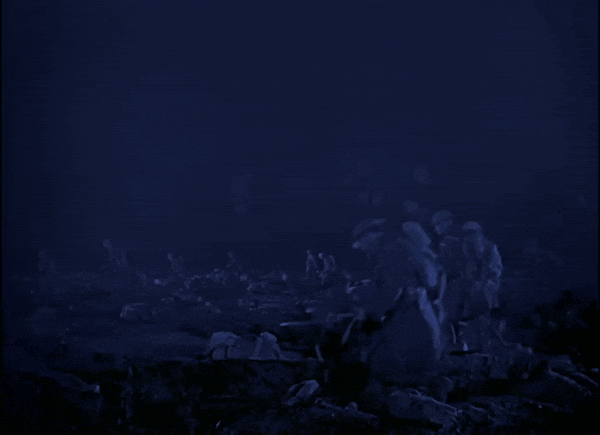

SO critical is the public that the building, photographing and printing of these miniatures must be of the very highest type of workmanship obtainable. It might be interesting to know that this work in "The Big Parade" alone cost approximately $70,000 for the background negative and the moving mat negative. The miniature battlefield was about one hundred thirty-five feet long and more than seven thousand miniature shells were fired in a period of forty seconds.
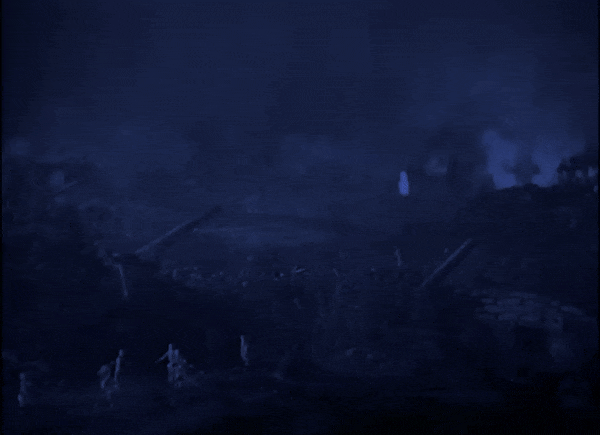



On another picture—"The Barrier"—which shows a fierce storm at sea, icebergs, and a ship caught and crushed in an ice floe, more than $85,000 have been spent to create these illusions.
[The Barrier (1926) is unfortunately presumed lost and I wasn’t able to find a depiction of this effect.]
Mr. Waller, technical camera expert of the Famous Players Long Island Studio, had never seen a cyclone; yet he was instructed to produce one for D. W. Griffith's picture, "That Royle Girl." Mr. Waller did extensive research work on the subject, and then made one to experiment with. A scientific knowledge of the working of the law of gravity, by the way, is necessary to create this phenomenon of nature.
[That Royle Girl (1925) is also presumed lost, and without film footage of this sequence there’s not really a way to know how the cyclone looked in the film. However, I do think the image highlighted in the advertisement below is likely from the cyclone sequence.
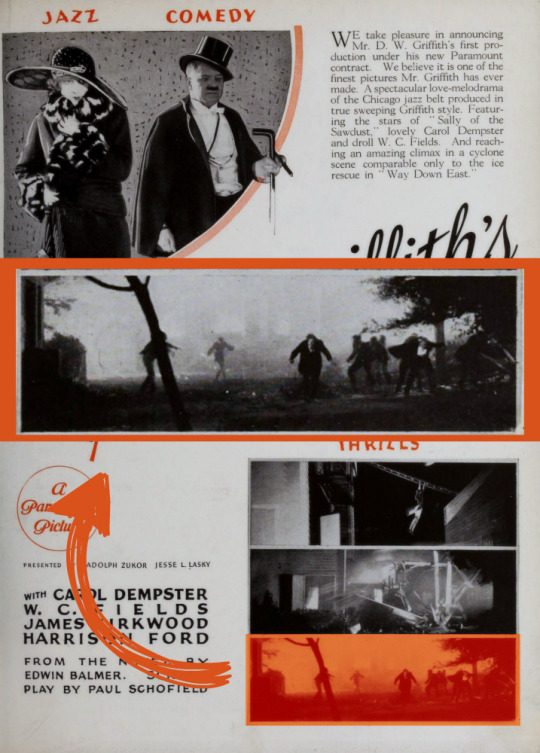
from Motion Picture News, 21 November 1925]
In the basement of the studio Mr. Waller connected up three vacuum cleaners. With three suctions of air and some dust, he made a tiny cyclone. This was photographed in slow motion so that the camera and technical crew might study the formation and activity of the cone.
From his observations of the film, Mr. Waller was able to prepare the series of wash drawings which, photographed in animated cartoon fashion, represented the action of the cyclone's cone in this sequence of the picture.
Several hundred drawings had to be made, each one depicting gradually the advance of the cone toward the Inn, which it finally demolishes. These were photographed in rotation on motion picture negative, and this negative double exposed on the 180-foot miniature scene containing the houses and trees. Thus we got a very good illusion of the cone of a cyclone advancing over a village and sweeping houses and trees out of its path.
[I wonder if/hope that some of these drawings have survived!]
The animated cartoon idea was also used in "A Kiss for Cinderella," when the pumpkin and mice change into the coach and four. The first few feet of the sequence showed real mice and pumpkin; from then on 256 wash drawings of the gradual transformation were photographed in rotation and gave the impression of being animated.
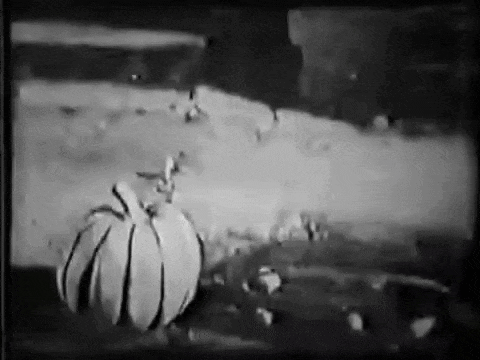
Double exposures of one actor playing two parts is the oldest and most familiar camera trick to the fans.
Just recently, however, has it been perfected to the point where the actor's two screen shadows can light each other's cigarettes and shake hands.
Tom Meighan, you recall, did this in Irish Luck."
AN invisible line from top to bottom divides each frame of the negative in half. One half at a time is exposed, photographing one half of the set.
Tom appears as Lord Fitzhugh on the left half, and as Tom Donohue on the right half. If you remember. Tom's two shadows are sitting side by side on a divan in the instance of the cigarette lighting. Fitzhugh leans over and gets a light from Donahue's cigarette. The illusion is perfect. But the cigarette from which his lordship really got the light was tacked onto a chair just outside the line, on the half of the set not being photographed at that moment. Only the lighted end of the cigarette projects into Fitzhugh's half of the picture.
[Irish Luck (1925) is extant at Eastman House, but it’s not currently easily accessible. I wasn’t able to find a depiction of this split-screen effect.]
Then when Donahue's half of the scene was being filmed, Tom leans forward and holds his cigarette in exactly the spot where the chair had been, the lighted end being outside his half of the picture. Think of the perfect matching this requires!
It is done this way. As Lord Fitzhugh performs on one side of the set, the director times his actions, counting the seconds out loud. He knows just where his lordship's right arm is, for instance, at the sixteenth second. When Donahue begins to perform on the other side of the set, his arm must be in a corresponding position at the sixteenth second. Tricky.
A thrilling moment in "Aloma of the South Seas," Gilda Grey's new picture, occurs when a shark eats a sailor. If you want this thrill, you naturally have to take it synthetic.
The shark cost $3,000. It was made of flexible rubber, and its insides consisted of a maze of electric wiring. Outside the body were several buttons which the actor could operate in his fight with the shark. It swims, wiggles its tail and bites electrically.
[Aloma of the South Seas (1926) is presumed lost and I wasn’t able to find images of the shark described here. However, as consolation, here is a photo from American Cinematographer of the film’s cinematographer Harry Fishbeck shooting on location in Puerto Rico:
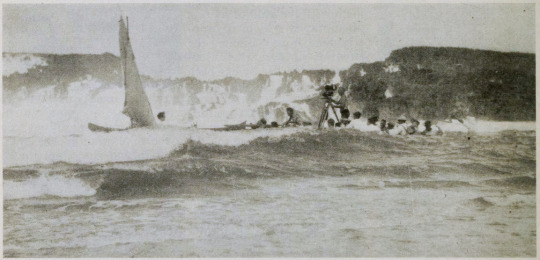
from American Cinematographer, February 1926]
I guess most of the suffering for art is done by the actors who tie themselves into knots to create the illusion of paralysis, amputated legs and so on. John Gilbert is shown in the last reels of "The Big Parade" with an amputated leg. Jack Barrymore in "The Sea Beast," also does it. It is merely a painful process of strapping the foreleg back. In "The Street of Forgotten Men," with Percy Marmont, a very lucid expose of cripple fakes is shown. Marmont had his arm strapped to his back for hours at a stretch during the filming of this picture. It hurts the first fifteen minutes, Percy said. After that the arm becomes numb.
A vigorous massage is necessary to bring it back to life, but it doesn't feel normal for weeks, Percy says.
Lon Chaney has his tricks of deformity down so pat that they are almost painless to him now.
#1920s#1910s#1926#classic film#classic movies#film#american film#my edits#silent film#my gifs#silent movies#silent era#silent cinema#cinema#film history#history#Roy Pomeroy#Frank Williams#Film Art#How'd They Do It#photoplay#lantern
58 notes
·
View notes
Text
as homestuck gets older and becomes more and more of a period piece i think it’s really interesting to see how continuations and fanworks take different approaches to maintaining that or not.
and i don’t want to outright say one is superior to the other. i think if you can find ways to introduce aspects of more contemporary pop culture or politics or technology into homestuck as a framework and still make it an interesting intentional choice then that’s a big achievement and not something to be scoffed at just by virtue of it being divergent from homestuck proper.
i think in a lot of ways it can keep it fresh and add a layer of relatability to the fans that grew up on it. after all, i think hussie was intending to make (or perhaps just coincidentally happened to make) homestuck relatable to his particular demographic of young adults on the internet in the late 2000s / early 2010s. i think rereading homestuck in my 20s really solidified this to me that homestuck was not intended to be a story about kids for kids but rather a story for adults about childhood and growing up. it’s funny that it wasn’t more obvious to me back then, or maybe i did pick up on it but i just didn’t really think about it all that much? because it’s so obvious. there’s so much 80s and 90s kid nostalgia in it and the tropes that the characters portray were already outdated or at least didn’t even really exist like they used to by 2009. and in many ways the characters themselves outgrow their own tropes and then later acknowledge it in the work itself both as time progresses and the narrative develops into something more complex and the characters become increasingly multi-dimensional.
i guess it’s just an interesting question to me. is having content in a story that will indefinitely age the work a “good” or “bad” choice? and several years down the line, will we be able to tell what choices were intentionally made so that it would one day be reflective of the state of technology / political landscape / pop culture at the time?
artists who set out to make their work as timeless as possible do kind of miss out on the opportunity to be a time capsule later on. or just generally representative of the climate it was created in, which is something that i think a lot of us can both appreciate but also find pretty unsavory about homestuck proper (cough dancestors cough) but then can i really say i wish those unsavory parts of homestuck didn’t exist? idk. they aren’t fun to read but i like that they make me think critically about the flaws of that particular part of internet history.
politics aside i think the fact that there’s a homestuck panel that incorporates vine is so cool. because it sort of inadvertently swallowed up a piece of internet history that would come to disappear into its already massive time capsule of media and pop culture and hussie didn’t even know. it’s just cool to me idk.
at the same time i think younger artists and writers that really prioritize keeping homestuck grounded in its era of internet and even going so far as to honor the nostalgia of an older generation is something i really admire and appreciate. and this is something that is becoming more common as homestuck ages (and becomes more of a period piece etc etc). i often find myself at a crossroads between exploring contemporary elements in my work and trying to emulate homestuck’s original tone and time period for the sake of preserving that integrity. like man. i could go on about this for such a long time because i feel like it’s just a really interesting discussion to see what we weigh as a meaningful divergence and refreshing change from homestuck proper vs what compromises the (for lack of better phrasing lol) “feels like homestuck” factor.
i think the discussions about sexuality and gender identity towards the end of comic and then further in the epilogues is an obvious example of this. hussie didn’t necessarily shy away from nuances of gender and sexuality but he didn’t really address them outright with labels either for the majority of homestuck proper until the end when other writers got involved. in early act 6 dirk is explicitly stated as gay (insert disney diversity win meme blah blah blah) but the character himself, which i feel like is an interesting reflection of hussie and homestuck’s general feelings about the topic of identity and labels (if i may speculate lmao), considers the act of labeling his sexuality as sort of this out of date, irrelevant thing in the grand scheme of things. whether that be in reference to who he is or what’s going on in the comic or a more metanarrative choice of hussie’s. some people interpret this to be a kind of admission of shame or maybe dirk just being pretentious but i personally interpret this as hussie kind of just being like. i don’t really want to spend too much time Talking about characters being gay i just want them to exist in the story and Be Gay. similarly to how the trolls don’t have a concept of sexuality in the same way the human characters do. it gives hussie an opportunity to have characters do Objectively gay things, from the reader’s perspective, without having to spell out their relationships to their own sexualities by real societal standards in the work itself when he was clearly more interested and comfortable talking about the trolls’ relationships to their fictional societal ones. and i think as a writer i find that pretty fair. (and yeah yeah i know another aspect of dirk’s whole deal is that he’s from the future so of course he would say that / the trolls are from another planet and all of this is in comedic foil to john i am not a homosexual egbert as the protagonist but i digress. idk i’m really only speculating here and maybe projecting lol)
bc tbh i also kind of shudder at the thought of writing gay characters who are always expected to spell out their identities to the audience when i’d rather just have them Do Actual Gay Things. (using gay as an umbrella term for lgbt+ yada yada). personally i’d rather have a scene where a character binds their chest to reveal an aspect of their gender presentation rather than feel obligated to spell out their relationship to their identity in words and explicit labels and also describe exactly how they Feel About All That. not because i want to cop out on representation and have their identities be totally open to interpretation necessarily, but more-so because i think it becomes exhausting sometimes as a gay person myself to have to keep acknowledging a character’s State of Differentness as obviously as possible every time i put a gay person in a piece of art.
not that i don’t find narratives that exclusively or heavily talk about and center themselves around identity and being in a State of Differentness in very outright ways important. to me that’s something very different and meaningful in completely different ways that can’t be accurately compared here. there are plenty of homestuck fanworks that make discussions of gender and identity a large priority that i think are extremely meaningful and one of the biggest reasons why i came back to homestuck after all these years and still really love the community of artists and writers that engage with it in this way. i think it’s an extremely wonderful thing, especially because with the homestuck community so niche, it really feels like a group of people spreading art that is, by a large majority, by gay people and for gay people. but in narratives that are not specifically centered around that, or has not centered themselves about that previously (like homestuck several acts into the comic) i can totally see how it comes across as off-putting. i think sometimes there’s a slippery slope with bigger projects with a large audience where the existence of gay characters in the work start to read as teaching tools for non-[insert identity here] or virtue signaling. i.e. it stops feeling like media that the reader can identity with as a gay person and more like media that is trying to represent gayness “accurately and positively” for a straight reader (or perhaps a gay reader who is completely new to their identity and appreciate this kind of easy-to-swallow and comfortable introduction). i find that in cases like this, the “representation” more often than not falls into the pitfall of being extremely generalized and sterilized or even stereotypical. which is a whole conversation in itself. bc when an identity is always easy to digest and understand, it risks reducing this character to the identity itself. water is wet i guess lol. idk it’s just a tricky balance. but definitely something i think about a lot when i’m engaging with contemporary homestuck fanwork.
long aside but. all of this to say. i just find it interesting to see how homestuck, as a kind of specific multimedia form of art and storytelling online that seemed to set a new precedent for the webcomic format at large, has taken on a genre of its own like any piece of art does that is unique and off the beaten path in its execution. idk it just makes me think of art history in general. like it’s fascinating to me to see something like homestuck which was once very new and fresh to me become a piece of art that has aged enough to open discussion about approaching the framework of homestuck in either a traditional or contemporary way. as a continuation or a fanwork or an homage. i guess the only point i’m trying to make here is that i don’t think one is better than the other and there’s something i appreciate about both.
i feel like i’m kind of avoiding the elephant in the room here which is that there’s a lot of discussion going on right now about maintaining consistency with homestuck proper in the current continuation with homestuck2 and that’s sort of a whole other can of worms i don’t really want to get into. but i would like to acknowledge how interesting it is that these discussions really obviously highlight how fast memes get “stale” nowadays in the current state of social media and everything seems to exist in a perpetual state of blink-and-you-miss-it virality. i really sympathize with the homestuck2 team who i’m sure are feeling a huge amount of pressure to strike a balance between making something refreshing / relatable to the current homestuck audience and also maintaining the “feels like homestuck” factor. all the while attempting to fulfill as many reader wishes as possible within reason. (not to mention the standard of “reason” being extremely subjective) it’s not an easy thing to do and definitely a hugely different creative process than the one hussie went through during early homestuck days. each with their own complicated hoops to jump through in terms of Making Art People Will Engage With.
59 notes
·
View notes
Text
Rewind the Tape —Episode 4
Art of the episode
Just like we did for the pilot and for episodes two and three, we took note of the art shown and mentioned in the fourth episode while we rewatched it. Did we miss any? Can you help us put a name to the unidentified ones? Do you have any thoughts about how these references could be interpreted?


Bust of a Woman with Her Left Hand on Her Chin
Edgar Degas, 1898
Degas, whose work already appeared in the second episode, was a French painter of the 19th to early 20th century. His impressionist paintings often depicted ballet dancers, racehorses, and human portraits of isolation. [Identified by @terrifique.]
Krumau on the Molde, Kneeling Girl with Spanish Skirt and Self portrait in a jerkin with right elbow raised
Egon Schiele, 1912, 1911 and 1914
Schiele, whose work we have also been seeing around Rue Royale since the pilot, was an Austrian Expressionist painter, very prolific despite passing before turning 30. His work is recognizable for its transgressive portrayal of the nude body, including his nude self-portraits; but his later oeuvre features many landscapes.
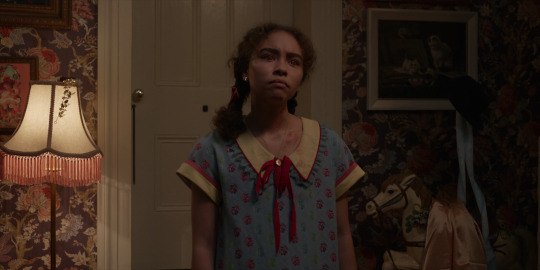
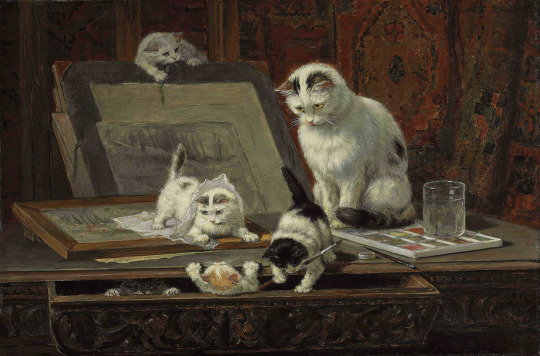
The Kitten's Art Lesson
Henriette Ronner Knip, 1821-1909
Knip was a Dutch-Belgian romantic style artist best known for paintings of animals, particularly cats and dogs of a playful nature. See more of her work here. [Identified by @terrifique.]




Nosferatu
F.W. Murnau, 1922
Nosferatu is a silent expressionist horror film from the legendary German director F.W. Murnau. It is an unauthorized adaptation of Bram Stoker's Dracula. While not a commercial success upon release in 1922, film historians now consider it an influential and revolutionary film in the horror genre. Since it has been in the public domain since 2019 in the U.S., it is now free to stream on YouTube.


New York
George Bellows, 1911
Several of Bellows' pieces have been featured in previous episodes. He was an American realist painter, known for his bold depictions of urban life in NYC. His work "revolutionized the conventions of the traditional American urban vista and surpassed the efforts of other contemporary urban realists" [x]. [Identified by @nicodelenfent, here.]


Backstage at the Opera
Jean Beraurd, 1889
Beraurd was a Russian born French painter known for his depictions of Parisian life and society during the Belle Epoque. [Identified by @nicodelenfent.]
Unidentified works
In Claudia's room: above the Knip we can see a painting of what looks like four people, maybe women sitting at a balcony. To the left of the door we can see, on top, a floral bouquet over a dark background, and below that, an illustration or painting of a woman with flowers over a bright pink background.
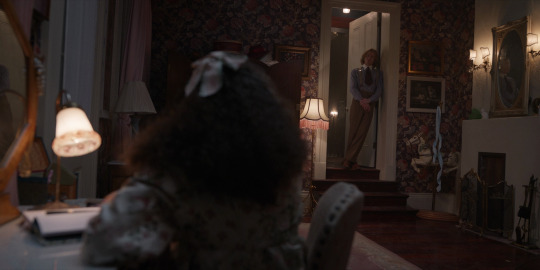
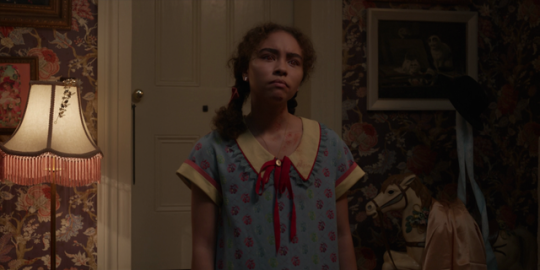
And, of course, there's that incredible piece on the wall of the reading room! We haven't found any statements from the set designer or art director about it, but we remain on the lookout for any information.

If you spot or put a name to any other references, let us know if you'd like us to add them with credit to the post!
Starting tomorrow, we will be rewatching and discussing Episode 5, A Vile Hunger for your Hammering Heart. We can't wait to hear your thoughts!
And, if you're just getting caught up, learn all about our group rewatch here ►
#the vampire claudia#claudia iwtv#louis de pointe du lac#daniel molloy#lestat de lioncourt#vampterview#interview with the vampire#iwtv#amc interview with the vampire#interview with the vampire amc#amc iwtv#iwtv amc#IWTVfanevents#rewind the tape#analysis and meta#art of the episode#the ruthless pursuit of blood with all a child's demanding
31 notes
·
View notes
Note
hii I have a community question so I thought I'd reference your encyclopedia
are there any references to music that abed listens to? I know they do it for other characters sometimes (like I'm pretty sure britta said she liked the pixies but maybe I made that up) anyway I'm trying to make a playlist about him
thanks<333
hey! thanks for the ask 💯
after sitting here and scanning my brain’s database (and searching the internet) unfortunately I haven’t come up with much… I did remember about this:

which is part of the whiteboard Abed had set up in 1x21 Contemporary American Poultry, on which he says he likes banjo music lmfao
the only other things I can think of are probably not very helpful at all, but I’m writing them down anyway lmao. he participated in defending The Barenaked Ladies from Jeff’s criticism (although, the entire group does that, and it probably doesn’t speak much to abed’s specific music taste), and maybe there’s a song he put into one of his documentaries or something? although, I’m pretty sure most of, if not all, the scoring for those is the same as the scoring for the actual show itself. he also dances to Roxanne by The Police in Remedial Chaos Theory, but, again, the whole group does, and everyone knows that song. also, at the end of 1x14 Interpretive Dance, he is shown tapdancing, and Merry Happy by Kate Nash is playing. but, I don’t think he put on the song himself— in fact I don’t think he can hear it at all, I think it’s just score. so, again, probably doesn’t speak to his actual music taste. but, in my personal opinion, that kind of music fits him the best, so I might look more into Kate Nash and related artists if I was making an Abed playlist.
so, yeah… his pop culture references don’t really seem to include music lol. there’s a chance he listens to movie soundtracks sometimes? movies like Back to the Future have some more commercialized songs on their soundtracks, so maybe he’s into that. looking more into soundtracks from classic 80’s films might help you a bit.
I did find this on his twitter (if you don’t know about the twitter character accounts lmk that’s a whole other can of worms that I am happy to open with you all) so obviously he has music he listens to, but I scrolled through all his tweets and he never mentions any specific artists or songs. lame

but yeah. sorry that this was all I could do, dude. I’m gonna open the floor to anyone who has any Vital Information™ that I missed, or for anyone who just has some headcannons or opinions on what they think Abed might listen to. thanks again for the ask and I hope this was at least semi helpful o7
(also, you’re right about Britta liking Pixies! she has a poster up in her room in the cold open of the season 2 premiere, and also there’s this Jeff quote from Digital Estate Planning: “this place is twenty cat turds and a Pixies poster away from being your apartment.” she also likes Natalie is Freezing, but they only exist in the Community universe unfortunately lol. but at least those two things give us a handle on what music Britta likes. Abed remains an enigma lmao)
#community encyclopedia#debuting this tag on thr off chance it’s useful to someone someday#community#nbc community#community nbc#abed nadir
59 notes
·
View notes
Text
Queer Woman-led Contemporary Fiction
There are some affiliate links below in case you want to support MQH.
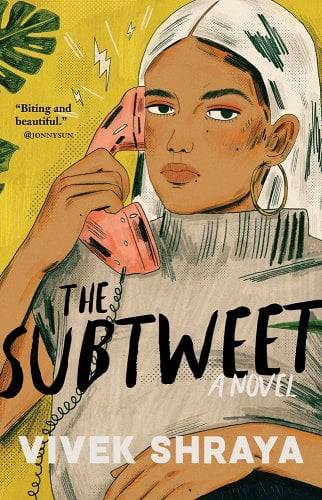
The Subtweet
Vivek Shraya
Indie musician Neela Devaki has built a career writing the songs she wants to hear but nobody else is singing. When one of Neela's songs is covered by internet artist RUK-MINI and becomes a viral sensation, the two musicians meet and a transformative friendship begins. But before long, the systemic pressures that pit women against one another begin to bear down on Neela and RUK-MINI, stirring up self-doubt and jealousy. With a single tweet, their friendship implodes, a career is destroyed, and the two women find themselves at the centre of an internet firestorm.

Sadie
Courtney Summers
When popular radio personality West McCray receives a desperate phone call from a stranger imploring him to find nineteen-year-old runaway Sadie Hunter, he's not convinced there's a story there; girls go missing all the time. But when it's revealed that Sadie fled home after the brutal murder of her little sister, Mattie, West travels to the small town of Cold Creek, Colorado, to uncover what happened. Sadie has no idea that her journey to avenge her sister will soon become the subject of a blockbuster podcast. Armed with a switchblade, Sadie follows meager clues hoping they'll lead to the man who took Mattie's life, because she's determined to make him pay with his own. But as West traces her path to the darkest, most dangerous corners of big cities and small towns, a deeply unsettling mystery begins to unfold- one bigger than them both. Can he find Sadie before it's too late?

Ghost Wall
Sarah Moss
In the north of England, far from the intrusions of cities but not far from civilization, Silvie and her family are living as if they are ancient Britons, surviving by the tools and knowledge of the Iron Age. For two weeks, the length of her father's vacation, they join an anthropology course set to reenact life in simpler times. They are surrounded by forests of birch and rowan; they make stew from foraged roots and hunted rabbit. The students are fulfilling their coursework; Silvie's father is fulfilling his lifelong obsession. He has raised her on stories of early man, taken her to witness rare artifacts, recounted time and again their rituals and beliefs--particularly their sacrifices to the bog. Mixing with the students, Silvie begins to see, hear, and imagine another kind of life, one that might include going to university, traveling beyond England, choosing her own clothes and food, speaking her mind. The ancient Britons built ghost walls to ward off enemy invaders, rude barricades of stakes topped with ancestral skulls. When the group builds one of their own, they find a spiritual connection to the past. What comes next but human sacrifice?

You Made a Fool of Death with Your Beauty
Akwaeke Emezi
Feyi Adekola wants to learn how to be alive again. It's been five years since the accident that killed the love of her life and she's almost a new person now--an artist with her own studio and sharing a brownstone apartment with her ride-or-die best friend, Joy, who insists it's time for Feyi to ease back into the dating scene. Feyi isn't ready for anything serious, but a steamy encounter at a rooftop party cascades into a whirlwind summer she could have never imagined: a luxury trip to a tropical island, decadent meals in the glamorous home of a celebrity chef, and a major curator who wants to launch her art career. She's even started dating the perfect guy, but their new relationship might be sabotaged before it has a chance by the overwhelming desire Feyi feels every time she locks eyes with the one person in the house who is most definitely off-limits--his father. This new life she asked for just got a lot more complicated, and Feyi must begin her search for real answers.
#queer#lgbt#transgender#queer books#lgbt books#ghost wall#sadie#you made a fool of death with your beauty#the subtweet
106 notes
·
View notes
Text
was talking about it the other day but its sad how we are never going to get really big budget games w/ funky artstyles again. like if you look at the majority of big budget releases lately, they are all kind of going for the same thing as far as actual modeling goes- hi fi, super detailed complex models that try to portray as much detail as possible. which is fine for certain games, but it makes me miss the big swings devs used to take.
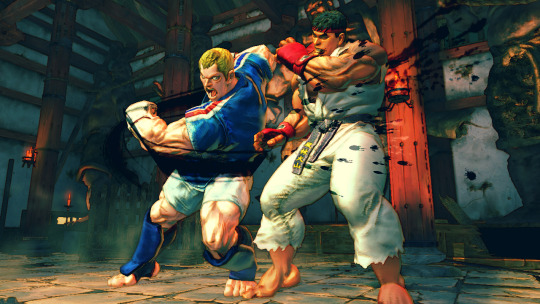
take street fighter 4 for instance- despite being over 10 years old at this point, it still looks REALLY good. great art direction, has a weird painterly look so everything has a cool watercolor style to it, models are expressive, etc. and this was a BIG release, its not some indie game (where most big stylistic swings tend to be made nowadays).
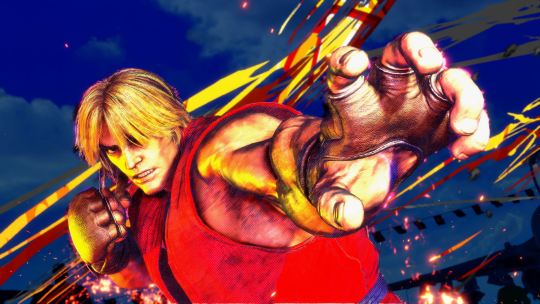
compared to street fighter 6, which is going for photorealism (with strong choices made as far as animation and color goes) it looks dated in the context of graphics generally, but looks WAY better than its contemporaries from the same time period. my fear is that street fighter 6 wont look that great in 10 years time.
side note, its also why street fighter 5 was really only loved by hardcore fans. it does nothing particularly well! its a halfway point between realistic and artistic to the point where it feels like a side-grade rather than an improvement or even its own original idea!

whatever leaps were made in lighting and texture quality are essentially irrelevant here. fucking gross!
the thing is, i dont think this is a deliberate choice that devs are making right now. from what i can tell, recent rendering tech has made it way easier to achieve a handful of lately- hi fi LIGHTING, increased TEXTURE DETAIL and HI POLY COUNTS come to mind. these are cool, but if youre a dev who wants to make a triple A product, you kind of have to use whatever tech is on the table to make a product look cutting edge. none of those encourage taking wild stabs at cool art directions. devs used to use those cool art directions because it was the ONLY OPTION THEY HAD.

classic case being windwaker right. the gamecube was a huge graphical leap from the n64, where even getting a model to look like something was a challenge. compared to ocarina of time, windwaker looks absolutely fucking incredible. it got a lot of pushback at the time for being too kiddy, but really the strength of its style is a result of doing as much as they possibly could with the platform they were working on. no high poly counts, the shading tech was relatively simple, and the textures (while a huge improvement over the n64!) are still basic compared to what we have today. windwaker still looks impeccable to this day, and even the HD remaster they made which, ahaha, improved WHAT

LIGHTING and TEXTURE DETAIL. but without a real consideration for the original artstyle (or why it even existed... which was the gamecubes limitations) it just looks worse.
in response to this pushback (i think, idk i didnt work at nintendo at the time) they gave twilight princess a way more "realistic" look. but given the rendering restrictions of the time, it still has a fairly robust artstyle
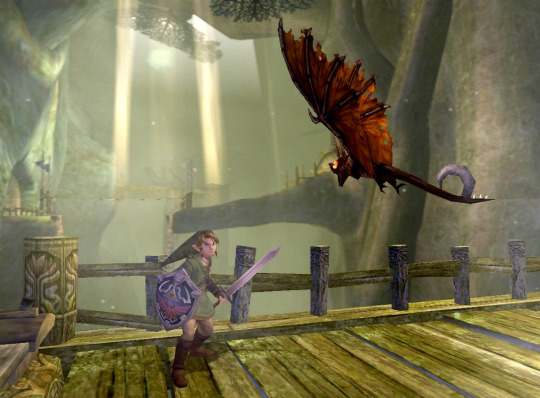
proportions are more realistic obviously, but in order to achieve that realism without the kind of lighting tech we have now the "lighting" is BUILT Into the textures. look at links sword, how it kind of darkens near the hilt, or how the shadow on the keese's wings is just kind of painted in specific areas. i would argue that twilight princess looks a LOT like street fighter 4 in that area-
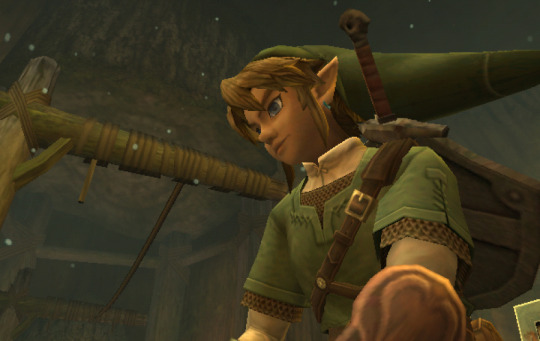

damn! they almost look like theyre from the same game! but twilight princess was celebrated for being "realistic" while sf4 was noted for having a funky watercolor style (thats built into the focus attacks even!). its so so smart, because the devs knew they couldnt go for photorealism (like so many games of the era tried at and completely failed at!) so they went for a mix of cool stylistic decisions that allowed a game to look GOOD in a subjective, artistic way.
Not that games don't try and apply artistic principles now, but its a lot less unique. look at mario odyssey

its just a beach. and it looks great, its well rendered, but its just a beach. colors are clearly intentional and very pretty, but it's nothin that special right now, probably will look even less special in 10 years even compared to levels in the same game.
what im curious about is when are we gonna get back to that kind of artstyle meets rendering tech! if ever! current tech makes it so devs are kind of forced to go down the same boring path. look at mortal kombat 1:

im sure there are some leaps in texture and lighting, but they keep taking shortcuts. all the faces are modeled after REAL peoples faces and they mocap for expressions/conversation, which gives a really boring look to it. the fact that mk11 and mk1 look so similar so many years apart (4 i guess isnt that much but there have been leaps!) is disappointing to me.

then you have tekken 8, which is like the best looking game ive ever seen. for a while i found it hard to put my finger on why, but my brother said something really smart i feel- they made all of these models by hand. theyre essentially digital statues. they didnt pull actual face models, they just worked on their features until it looked correct. on top of the lighting and texture work, it creates a look not unlike the renders tekken has been using for years. which is convenient for them, because they can finally match the kind of real-time fidelity they've been chasing for like 30 years

hell it looks BETTER than that. so what im trying to say is im hopeful that art direction will catch up with the kind of rendering tricks/strengths we have.

i think tekken 8 feels like how soul calibur 2 probably felt at launch. does a lot of the same things given the time period
i still think hi fi rendering doesnt make for a good looking game, but rather where the focus lies for the player. for tekken it makes sense that they would focus their horsepower on detailed models and stages- youre gonna be lookin at that forever. look at elden ring

texture wise, SUPER low res for 2022. maybe even 2020. but what they do with the horsepower is genius- they focus on scale to translate locations of objectives to a player while also reinforcing the feeling of adventure, on top of extremely strong choices in color and lighting. i hope, going forward, games focus on how they can use this kind of tech to reinforce a games "gameplay mission statement" while keeping strong artistic choices present rather than focusing on being able to wow someone with a couple of screenshots at the cost of BOTH of those things. im just ranting though french press got my ass
133 notes
·
View notes
Text
Dance HCs for the Redacted bois :)
David: Ballet
My man likes rules and ballet has those rules. He was the best at partner work and lifted those girlies into the air with no problem. The pack teases him abt it sometimes but angel loves it. They constantly ask him to teach them variations.
Asher: Classic Jazz/Hip-hop
I think he was enrolled in jazz classes as a kid and really enjoyed it. Later on, he thought hip-hop was really cool so he watched a bunch of videos on it. yes, self-taught hip-hopper ash. he's an absolute beast at clubs and definitely dances to the songs playing at grocery stores.
Milo: BALLROOM
PLEASE HE'S LITERALLY PERFECT FOR THIS ARE YOU KIDDING? He loved every aspect of it: the style, the costumes, the competition, EVERYTHING. He was really good at it too, he won like 90% of the competitions we was in. He definitely had a massive rivalry with another person and was petty abt it.
Vincent: Contemporary Ballet
not necessarily ballet but it has a certain artistic element that he enjoys. He took a few classes as a kid and then enrolled in some classes at his college. I just think that he would be really good at it and it's not super traditional.
Sam: Country Western
my guy is from the south what did you expect? anyways he went to a lot of shindigs as a kid and then went to country clubs in college. He's goated at partnering too. he spins his partners around and lifts them into the air with ease. Even tho darlin is made of steel he can still pull crazy stunts.
William: Ballet
He's literally from France and was the reason why Tchaikovsky wrote the Nutcracker. He KNOWS his stuff.
Gavin: Jazz
Okay a bit different, but I think that he enjoys the more mature jazz/theatre. Like cabaret, chicago, and moulin rouge. he LIVES for that shit. fosse is his idol bro. he occasionally surprises freelancer with a little number lol
Damien: Ballet
my man went far with this like he was GOOD. He was definitely enrolled in a professional company before he went to damn. He was super particular about every move and argued with people during variations. He even got annoyed at the girls he was paired with because they weren't certain moves correctly. The other dancers didn't like him very much, but those russian ballet teachers did, and that's why he got so many good roles in the shows he was in.
Lasko: Musical theatre
okay, hear me out here. he's a show tunes guy. he loves newsies, grease, and hamilton and was for sure a theatre kid before his powers manifested. Like can you imagine how cute that is? he's a little bit embarrassed about it but when freelancer asks him about it he pulls out the old CDs. pls so cute
Huxley: Rhythmic tap
no not theatre tap like he goes hard with the rhythms. you really wouldn't expect it but you can sometimes catch him tapping when he's sitting or waiting in line. he's an absolute beast at it.
Caelum: Lyrical
he loves all of Maddie Ziegler's solos. the likes how much emotion is put into every move and gets very invested in the stories he tells through the movement. he also really likes all the pretty costumes.
anyways this is all just my opinion and I miss dancing a little bit. :P
#redacted audio#redacted asmr#redacted headcanons#redacted david#redacted asher#redacted milo#redacted vincent#redacted sam#redacted william#redacted gavin#redacted damien#redacted huxley#redacted lasko#redacted caelum#redacted shaw pack#redacted solaire clan#redacted damn#i made this during a road trip lol#should i make more of these?#it was pretty fun
170 notes
·
View notes